



Featured Image: Olia Lialina, My Boyfriend Came Back From The War, at MU. Photo Boudewijn Bollmann
Twenty years ago, in 1996, Russian artist Olia Lialina created My Boyfriend Came Back From The War (MBCBFTW). Using the story of a veteran’s girlfriend who has mixed feelings when he returns, the interactive Web narrative quickly became an iconic work that inspired many artists to create their own interpretations of it. At the moment two exhibitions at HEK in Basel and MU in Eidhoven, pay hommage to MBCBFTW, a tribute to a medium and a new approach to keeping history alive.
Participating artists
Inbal Shirin Anlen, Freya Birren (Jennifer Walshe), Vadim Epstein, Dragan Espenschied, JODI, Olia Lialina, Abe Linkoln, Guthrie Lonergan, Armin Medosch, Ignacio Nieto, Anna Russett, Tale of Tales a.k.a. Entropy8Zuper!, Mark Wirblich. With two new works by Constant Dullaart and Foundland (commissioned by MU).
Educated as a journalist and film critic, and curating experimental film programmes in Moscow, in the mid-1990s Olia Lialina quickly embraced the Web and started experimenting with its unique qualities. She made her first net art piece, My Boyfriend Came Back From The War in 1996. Four years later she set up the Last Real Net Art Museum – an initiative to oppose museums that were presenting the first ‘Internet art exhibitions’, and a place on the Web where she could collect and exhibit the projects that responded to MBCBFTW. Ten years after she made her first net artwork, in 2006, in their popular book New Media Art (Taschen) Mark Tribe and Reena Jana wrote about MBCFTW: ‘One indicator of the historical significance of Olia Lialina’s 1996 Net art project, My Boyfriend Came Back From the War, is the numerous times it has been appropriated and remixed by other New Media artists. (…) Perhaps it resonates with other artists because it is among the earliest works of New Media art to produce the kind of compelling and emotionally powerful experience that we have come to expect from older, more established media, particularly film.’
In the meantime, Lialina had moved on and in addition to her online art practice, wrote about new media, Digital Folklore, the vernacular Web, co-founded the Geocities Research Institute, and became an animated GIF model and a professor at Merz Academy in Stuttgart, whilst the ‘mini-drama in hypertext’ MBCBFTW continued to be of interest to many artists, curators and critics. For its fifteenth anniversary, The Creators Project described MBCBFTW as a ‘charmingly simple yet poignant work’, emphasising its importance for the history of net art and its longevity through its interpretations. At the moment, as Lialina tells me, the project is discussed on Twine – an open source tool for telling interactive, nonlinear stories – where people communicate with each other about this ‘early Twine’. It is therefore not surprising that 2016 starts with two anniversary exhibitions, opening almost at the same time but in different frames, of My Boyfriend Came Back From The War. online since 1996. In what follows I asked Olia Lialina to reflect on the lasting popularity of the work, her intentions for making it, and her ideas about ways to go forward with it.
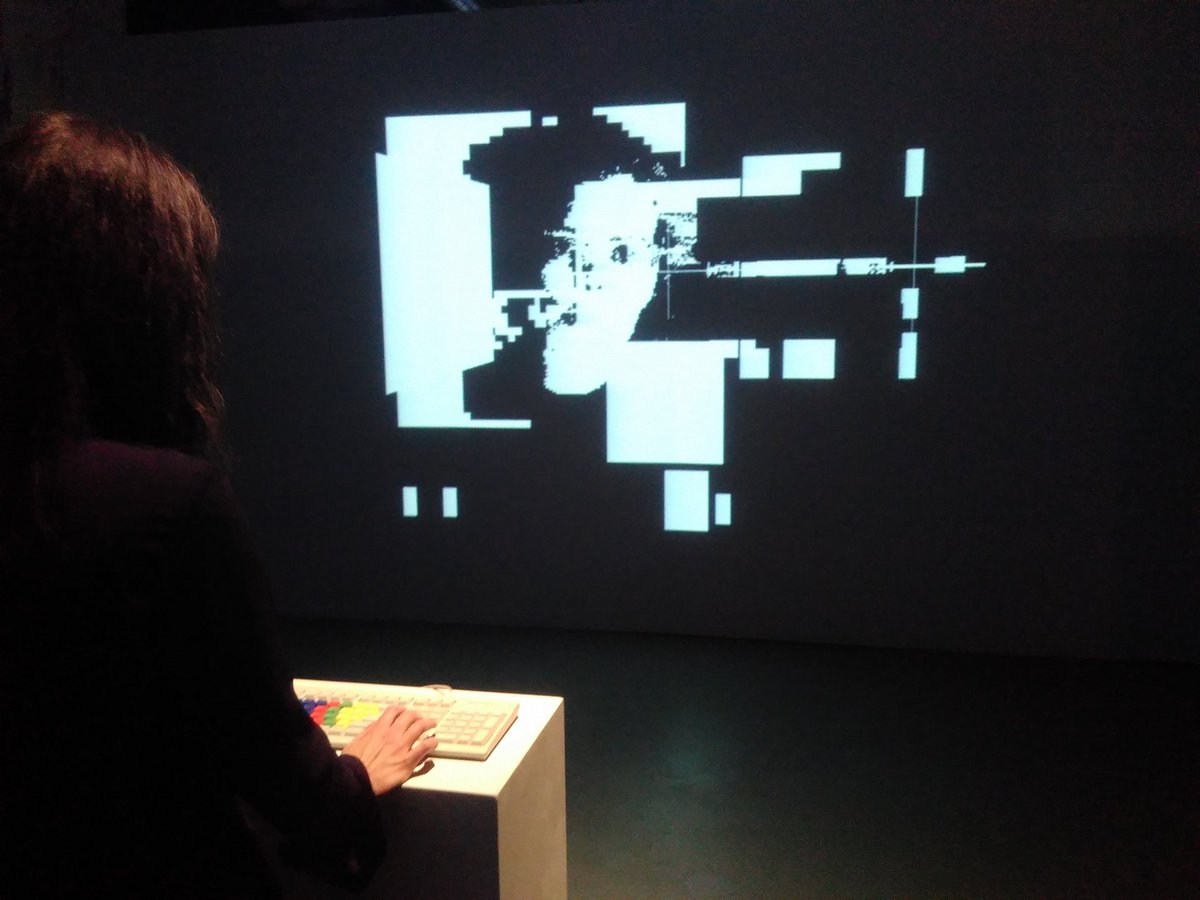
Can you tell me something about your background, how did you end up being an artist and a professor?
Twenty years ago I was absolutely happy with what I did: writing about films, curating film programmes, trying to make my own films. But as with many who embrace the World Wide Web (or were embraced by it) when it left academia in the mid-1990s – I was lucky to have a sudden new life and career. I became an artist only because MBCBFTW became a piece of net art. And I could become a professor four years later because of it 🙂
Could you briefly describe what the work is about?
In my teens I came up with the sentence ‘My boyfriend came back from the war, after dinner they left us alone.’
Мой парень вернулся с войны
И вот мы остались одни
And I always wanted to complete it as a poem, but the next lines never came. Years later, still confused about the phrase, I made it into an ambivalent dialogue with the browser: dividing it into frames. It was never about a war, but about a difficult conversation that doesn’t lead anywhere, and of course about the browser. I wanted to make something that people would spend time with and look at in the browser. This was also possible back then because the connection was much slower – so it took time to go through it. This has changed a lot now: HTML adapts to faster speeds, and most of us aren’t used to waiting – or loading time – anymore. You cannot click slowly if something is fast. That is also why we artificially slowed down the Internet connection for the exhibition.
When you started working on the Web, you came from a background in journalism and film. What sparked your interest in HTML frames?
They were very new at the time, not every browser supported them and you had to install the Netscape 3 version that had just been released – although in specifications I see now that it also worked in Netscape 2, but I remember that it didn’t back then. So, at the time it was cutting-edge technology – even though there was already a ‘I-hate-frames’ movement on the net, which I only discovered later. For me, it was interesting to see that a browser window could be divided up: you could assign coordinates, partition the screen and have multiple HTML documents within the same window. It sounds naive now, but at the time it was very empowering: I felt like a hacker, I could decide what it looked like and how it functioned.
And it reminded me of celluloid. I used to work with experimental 16mm film: cutting and pasting frames together. The editing was a way to work with the material, not just a concept. So, the connection between film and browser frames was something exciting. At the time I always talked about MBCBFTW as a net film. Someone more familiar with CD-ROM art, programming or interactive art would probably see it differently, but for me using frames inside the browser was a way to edit – it was a direct transition from being a filmmaker to a net artist.
While preparing the inventory table with all the elements of MBCBFW for the exhibition and reviewing the HTML code, I saw so many mistakes that I felt a bit ashamed. Mona Ulrich, one of my students, and I noticed warning after warning while reading through the code. So, it’s not only an old code, it is also very buggy, but despite all that it still works! That is the great thing about HTML, it has a very high tolerance, and it’s very forgiving if you write ‘bad’ code. It allows you to make mistakes: it’s not even that it was easy to learn, but rather that you didn’t really have to learn it at all.
In 2000 you started the Last Real Net Art Museum, as an initiative to collect and present interpretations of MBCBFTW. Could you explain the context and purpose of the Last Real Net Art Museum?
The Last Real Net Art Museum was a provocation to museums who in the late 1990s and early 2000s started making their own online net art exhibitions and collections – and at first they seemed to succeed, but it turned out they didn’t. In my title, ‘Real’ meant that an online collection should be based on links, because the net was about making links to people, information, etc. A good example was äda ’web designed by Vivian Selbo and curated by Benjamin Weil for the Walker Art Centre in Minneapolis between 1995 and 1998. Because this and other projects ended, another phenomenon started with museums like the Guggenheim, Tate and Whitney who acquired copies of Internet art and just kept these somewhere on a floppy or a CD, or showed the work in a pop-up window on their website – for me this was not real, and rather disrespectful of the artworks. And ‘Last’ meant that this previous method was completely disappearing.
The Last Real Net Art Museum was also sort of self-referential because of the First Real Net Art Gallery that I made in 1998, where I sold net art. It wasn’t a gallery selling offline art online, but people could buy online art for the first time. Since the First gallery was still well known in 2000, and to make the connection between the works, the second one became the Last…
Talking about museums and collections, was MBCBFTW ever acquired?
Yes, there is a copy at Telepolis, which was sold for what I thought back then was the amazing sum of 300 German Marks, but it was above all a statement. It’s also in a museum collection, MEIAC (http://www.meiac.es/) in Spain, and has been bought by a private collector, too. There is one more edition left. For this one I think it makes sense to sell the complete package: a computer, a monitor with the right resolution (800 x 600) a slowed-down server connection, an emulator with the old Netscape browser and all the other settings. Everything is emulated, simulated and fake, but the work is alive in its most precious state.
I have also adapted the work at certain times, for example around 2006 I added Google Ads to the website, not to become rich, but to reflect the Web of that time. Without the Ads it seemed old-fashioned and I wanted it to be alive and contemporary. About a year ago I removed them, because they made the work look outdated. It was interesting to see what Google thought suited the site – mostly non-governmental sites. Unfortunately, I never captured this version. That’s the irony – part of me is very much involved in preserving the Web, but when it’s about my own work, I change things immediately and forget how it was before.
The adaptations to the medium are striking in all the different interpretations. Seeing all the works next to each other illustrates a historical technical lineage of online practices: from HTML frames to blogs, games, video and VR. In a sense the Web seems almost to be little more than a constantly changing technical environment. Many have argued that this emphasis on medium specificity is one of the reasons why it took/is taking so long for net art to be taken seriously by the traditional art worlds. How do you view the relationship between the concept and the technical or formal aspects of the work?
For me the main concept and message of the work is the medium specificity. When thinking about the MBCBFTW exhibition we noticed now that it is also about the development of the Web. Yes, it has many technical translations. For example, the work by Auriea Harvey and Michaël Samyn (previously known as Entropy8Zuper!) was made in Flash; it was interactive and had sound, and for that time it was the most obvious software to use. Then Blog and Twitter versions were made, people kept changing it to other realities of the Web. What is interesting though is that the last interpretation, by Inbal Shirin Anlen, brought it back to its original classic HTML structure. The variations are some sort of tribute to the medium: these can range from manifestations of particular elements, to an aesthetic message or a personal statement in the medium.
I strongly believe that there is no contradiction between medium specificity and a mature conceptual message. For that reason I also think that it’s important to always emphasise how the work is made – it just being ‘art’ is not enough; I cannot forget about the Web or the net. In my article ‘Flat against the Wall’ of 2007, I wrote that while it is fine that Web art is part of the art market now, it would be a tragedy if we lost its connection to the Web. It can be a topic of contemporary art but it should stay part of the new media art scene.
For the exhibition you choose specific interpretations. What were your criteria for this selection?
We had to make a selection because some things have been lost. At the time of the Last Real Net Art Museum I thought it was important to just have the links to the works rather than showing copies of the works. So, unfortunately now some works are missing because nobody saved them, the Internet Archive didn’t capture them, and the artists (some of them students at the time) said they didn’t have their work anymore. For example, Web comics were popular at the beginning of the century and someone made a version in that style, which unfortunately didn’t survive either.
In the exhibition we left out works that had a similar structure, but almost all of them are featured in the book that was made for the show by House of Electronic Arts (HeK) in Basel, for example, Don Quichote Came Back From The War (2006) by santo_file group. But we also left some out of the exhibition that – perhaps surprisingly – were just too difficult to show such as the beautiful animated gif by Mike Konstantinov. He made this animated gif in 2000 and it was widely used for and known as a website banner. This work was a typical banner, 468 x 60 in size, and because it doesn’t use any of the images from the original work is also mimicked the cheesiness of banners. In the book it is printed frame-by-frame, but it’s difficult to show the banner phenomenon in an exhibition. We thought of several ways: put it on a random website, or against a black background, but in the end we decided not to present it at all. It just didn’t work.
Another example that isn’t included in the exhibition is Roman Leibov’s work. Leibov is the unofficial father of the Russian Internet. In the mid-1990s the Web in Russia had a strong literary tradition, it was all about games with words and meaningful and innovative hypertexts, including of course many references to Russian literature. I made MBCBFTW in English to intentionally distance myself from this tradition. I wanted to create something very formal because I’m very interested in the structures of the browser, the frames, etc. Had I made it in Russian it would have ended up in a different culture. At the time it was a massive effort, because English wasn’t my language. Then I asked Roman Leibov to make a text version and post it on the Russian Internet, which he did. He took every frame and described it like a film critic, and it ends with a monologue, making it into a piece of literature.
How do you see this type of approach now? To me at times it seems there is much less experimentation with templates or in the browser.
Yes, it’s more difficult to be curious now. The browser is still generous, you can open the source code and look at it, but it’s very complicated to change the code, if you can do it at all. The gap between people looking at and those making the pages has become enormous now. At the time it was easy to copy and modify other people’s pages, but now it is much more difficult to do this.
In this sense, perhaps, Blingee is my favourite place to go at the moment. It is a creative community where people fulfil their wish to make something themselves, where they can construct something from other people’s material. It isn’t because they can’t afford Photoshop, it’s about finding things made by others and reusing them such that they become completely different, and also that those layers can be made visible again, showing the elements that have been used. All the layers in the images have value and they are there to be admired. You can also see the tricks people use to fool or misuse the system. Unfortunately, there isn’t a Blingee version of MBCBFTW yet.
What I like about the work from an historical point of view that it consists of two types of archives: the table with all the information and components that are necessary to reconstruct the work, and the living archive of different people’s interpretations. Which method do you prefer?
The archive is an interesting part. MBCBFTW consists of many files, yet it is only 72 KB in size, which is smaller than a small image today. In the early 2000s I wanted to write about the life of a work of art, its making, what is important to keep and its preservation, even though I didn’t think it was necessary for net art. Now I see that it does make sense to write down all these details, so Mona Ulrich and I updated the old table for the exhibition. The table shows all the files, their sizes and which one is used in what frame. Even if someone has never seen the work, it could be reconstructed by following the information on the table. Maybe someone should try it sometime.
However, thinking about the future of the work, I prefer the interpretative approaches, because they are closer to my way of working. I’m also happy, and proud, that people take it as a structure and build something else out of it. I also think it’s interesting to see to what extent it can still be recognised as being an interpretation of MBCFTW, what are those elements? For example, Ignacio Nieto made a tribute for the Chilean soldiers who died in the mountains, it’s his story, and he merely used the same frame structure, but he asked me whether he could make and show the work. It is a bit strange of course, because I don’t have a patent for the frames, yet the specific use of the frames is one of the work’s main characteristics. I also noticed that most people keep the left frame intact and the frames to the right proportionally become smaller. Perhaps it’s similar to the golden ratio in design, but then for frames. A final characteristic is that all the interpretations always end with nothing, with black frames.
The exhibitions My Boyfriend Came Back From The War, online since 1996 are on view till 20 March 2016 at MU in Eindhoven (NL) and HEK in Basel (CH).
Features Image: “Dead Copyright” installation view, 2015
Antonio Roberts is a digital artist based in Birmingham. In 2011 he has completed his Masters level studies in Digital Arts in Performance at Birmingham City University. His artwork focuses on the errors and glitches generated by digital technology. An underlying theme of his work is open source software and collaborative practices. His video work has been screened in Chicago, Illinois, at GLI.TC/H, Notacon in Cleaveland, Ohio, and Newcastle Borough Museum and Art Gallery, amongst other places.
In October 2015 he opened his first solo exhibition, “Permission Taken“, at Birmingham Open Media and in these weeks is taking part to “Jerwood Encounters: Common Property” (15th January – 21st February 2016, Jerwood Visual Arts), a group show curated by Hannah Pierce focused on the limits of Copyright when it’s about visual arts, with two projects: the installation “Transformative Use” and a collection of four works, “I Disappear”, “Blurred Lines”, “My Sweet Lord” and “Ice Ice Baby”.
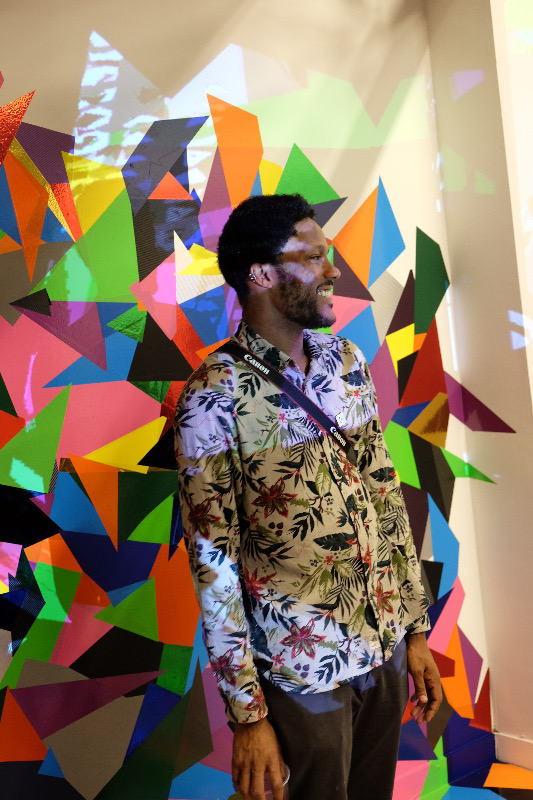
Filippo Lorenzin: You’ve been always interested in how corporate and industrial logics affect daily life and art. How did you get interested in these questions?
Antonio Roberts: It’s a by-product of my interest in open source software and free culture, something which I’ve been interested in from as early as 2002 but only started taking seriously around 2007. One of the main motivators of this was my reaction to Adobe Photoshop and its influence on creative practices. My experience of studying Multimedia Graphics – and I’m sure the same can be said for Graphic Design, Illustration and any creative practice – was that it seemed more like an exercise in how to use Adobe products, not how to be creative with tools. It felt like Adobe software had gone from being one of the many tools for creating art to the art in itself. This corporate sponsorship of course has many implications for how we create and disseminate art. It poses restrictions and dictates who and who cannot create art.

FL: Copyright issues are one of the main focuses of your research and this fascinates me because of your age. You (as me, by the way) have experienced probably the most troublesome period for Copyright systems, with the wide spread of p2p networking and remixing approaches to cultural industry products. What do you think?
AR: I’m inclined to agree. I’ve had access to the internet since I was around 14 years old and in that time I’ve seen the internet and culture as a whole change drastically. For me the rise and fall of Napster, spearheaded by Metallica’s very public outcry against it, signalled the beginning of the end of the free internet that I had only known for not even a year.
Around that time Digital Rights Management (DRM) became a hot topic. The entertainment industry saw it (and suing everyone) as the only way to protect their property and so kept bundling DRM with their products, which often at times resulted in a broken experience for the user. One example that springs to mind was the attempt to make CDs unreadable by computers (and so prevent ripping), by adding in corrupted data at the beginning of CD. Whilst it did temporarily stop people to using it on computers – you could simply use a marker pen to circumvent it – it also prevented some CD players from using the CD and in general was obtrusive. This cat and mouse game is still going on to the point where simply attempting to bypass DRM to watch/listen to something that you have purchased, can be an illegal act.
As mentioned before, It wasn’t until around 2007 that I began to reconsider how Copyright affected my work. By this time I saw that there was more weight being pushed behind open source software, free culture and things like the Creative Commons licences, and so I started to get involved myself. The first stage was ditching all proprietary software (which I did in 2009) and then licensing my work under Creative Commons licences.
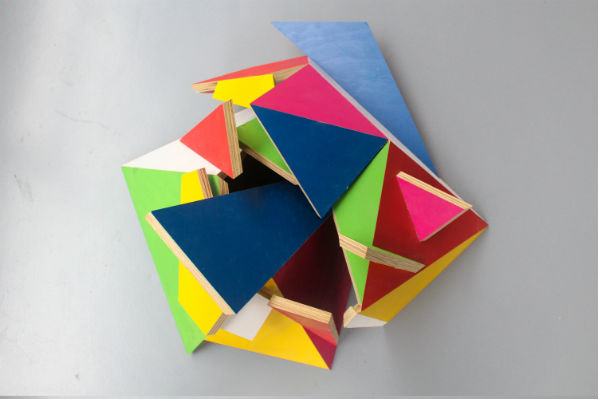
FL: “Jerwood Encounters: Common Property”, curated by Hannah Pierce, is a group show that seeks to investigate the new borders of Copyright, especially in regard of art. How would you define the state of these questions in UK?
AR: I think Copyright as a whole is in a terrible state. As Cory Doctorow suggests in the exhibition programme (which is in itself an excerpt from his book “Information Doesn’t want to be Free”) Copyright as we know it isn’t written for artists or any individual. Its verbose terms and complexities cannot be understood and are probably not even read by most of us. They are written for other lawyers. If, in order to go about our creative business, we are expected to read and understand the terms and conditions and law – it is estimated that it would take 76 days to read all of the Ts and Cs of websites we use – what time do we have to be creative?
FL: What’s your point of view, from your position as an artist?
AR: I think Copyright is a mess because it tries to dictate how we should be creative. Creativity is free-flowing. Copyright, and its cousins patents and trademarks, justify their existence by saying that these restrictions encourage innovative new ideas but what they do is just stop us.

FL: “Dead Copyright” reminds me some reflections by Walter Benjamin on the shock of the city, about how advertising assaults our senses 24/7 with louder and louder messages – until it reaches a state of entropy. At this stage the message isn’t actually more important than the media itself, quoting Marshall McLuhan, and all the brands create a single, colourful ambient. How much this reality has been voluntarily planned by corporations, in your own opinion?
AR: I think it’s all completely planned. The more pervasive the advertising becomes the more we accept it as part of our every day life and culture. On the other side this does mean that they have to try ever more invasive methods to get our attention. Think about the uproar over the Coca Cola van at Christmas, or Cadbury’s at Easter. They have usurped the original holidays and are more important.
FL: The reduction of brands to colorful simple shapes created something that visually reminds some of op art works, a movement that experimented with visual perceptions and that has been an important inspiration for fashion and design. I was just wondering what you think of this similarity: is there any real connection between your work and those works?
AR: Yes, certainly and this comes through with my use of glitch art techniques. In glitch art we’re often trying to find signal in the noise, and I find that many successful glitch art works (however you define successful) have some resemblance to the original yet are transformed and destroyed in way.
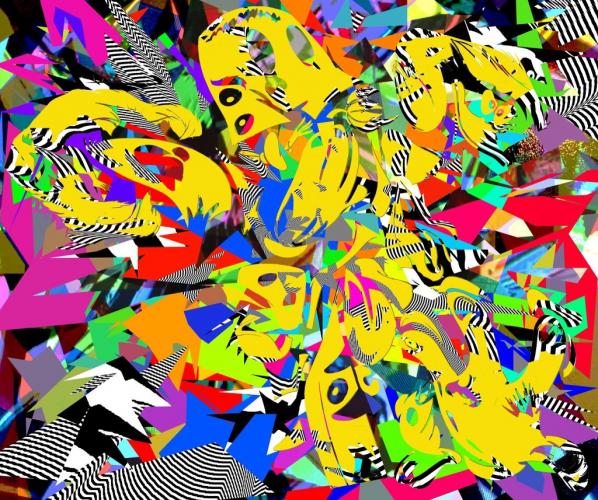
FL: With “Transformative Use” you use shapes that recall not just brands, but a wider imagery. It’s as if you’re focusing on other targets: can I ask you how did you get interested in this new research?
AR: I recalled all that I had learnt during my residency at University of Birmingham and during the CopyrightX course. From this I paid particular focus to the Sonny Bono act from 1998. This effectively extended the Copyright terms so that it won’t be until 2023 until works from 1923 begin to enter the Public Domain. This act is sometimes called the Mickey Mouse Protection Act, which led me to use them as a focus point for the work. Mickey Mouse should, by now, be in the Public Domain but they’ve fought to stop this in order to “protect” their brand.
People in favour of long or perpetual Copyright terms usually point to it allowing artists to reap the benefits of creating work. In truth, however, only a very small percentage of works made will be profitable in the future. To put it another way, how many books published today will see reprints? I don’t have any official statistics, but I know it would be a small percentage. So, extended Copyright terms only really benefit the small percentage of artists or publishers, whilst harming everyone else.
FL: What does it mean to deal with corporate imagery within such a chaotic and in a somewhat charming ambience? I mean, what remains a logo or a character when it gets lost within this borderless blob? Are the corporations losing their borders too, maybe?
AR: Yes.
FL: As discussed before, “Transformative Use” has been inspired by two previous projects: do you think that in future you’ll make a work that will update for the fourth time these reflections of yours?
AR: Most certainly yes. “Permission Taken” will be having an iteration at the University of Birmingham in March 2016 and will feature new and existing work. Aside from this I will continue to work with found materials but with a more explicit intention to provoke discussion around Copyright.
In a mysterious pine forest, inhabited by half-human, half-animal creatures, the dismembered white body of a furry god is slowly reassembled. A creature with the head of a black bear pulls down the decapitated body from a tall rock. A red-robed character with a crimson wolf’s face, decorated with sharp white teeth, fetches the severed head. Another brings the eyeballs; another, the skull. Finally, in an illuminated multi-coloured tent glowing in the darkness of the woods, a character with the head of a triceratops and a cloak of many-coloured feathers performs a ritual involving magic crystals and a dead bird doused in blood. The film ends with a single glimpse of the white god’s foot, planted in a field of snow, sufficient to suggest that he, she or it has been brought back to life.
I first came across Magic Blood Machine as one of the staff picks on the Vimeo site in October 2014. It was on a list of spooky videos for Hallowe’en. The rest of them looked fairly conventional, but the still for Magic Blood Machine stood out: the red-robed character from the film standing amongst dark pine trees, looking a bit like a Roman Catholic Cardinal, a bit like Anubis – the jackal-headed god of Egyptian mythology – and a bit like Reynard the Fox. When I watched the video, I was struck by the same mixture of associations: it seemed to combine elements of the crucifiction and resurrection of Jesus, the dismemberment and restoration of Osiris, and the Green Man myth. Folk-stories, mythology, the occult, the macabre, and even a touch of science fiction were all in the mix. But its visual design, filmic and narrative qualities were just as striking. There are no words spoken, and the pace is slow, but nevertheless the film exerts a powerful compulsion, partly because of the expertise with which each sequence unfolds and leads us to the next, and partly because it’s so full of unanswered questions. The actions of the strange characters in the pine forest seem charged with hidden meaning, as do the characters themselves, sharply-differentiated from one another as they are by virtue of the brilliant costume-design. There is a strong sense of place in the outdoor filming, and a strong sense of the tactile as well: the way the characters stroke the dead god’s fur, fondle the magic crystals or pour blood over the breast of the dead bird, for example. And despite the use of expressionless masks, there are moments of powerful emotion. When the red creature, having retrieved the white god’s severed head, lays it next to the rest of the body and then sits beside the corpse, holding its hand, it eloquently conveys a sense of love and grief.
Magic Blood Machine was made by a Norwegian artist and film-maker called Ingrid Torvund, in close collaboration with her partner Jonas Mailand, and with music by Jan Erik Mikalsen. It took three years to make (2009-12), and a sequel called When I Go Out I Bleed Magic – which Ingrid describes as the second part of a trilogy – was released earlier in 2015. For me, When I Go Out I Bleed Magic is less compelling than its predecessor, but if anything the design of the film, in terms of costumes and settings, is even more impressive. Ingrid makes almost all the costumes and props herself, and they are works of art in their own right, some of which she has exhibited separately. She has also exhibited her drawings and published many of them in a book, again with the title When I Go Out I Bleed Magic.

Ingrid’s work strikes me as an example of the enabling power of the Web, which can sometimes allow genuinely original artists to reach international audiences they would have found it very difficult to access at any time before the 1990s. It also allows the likes of me to get in touch and start up a conversation out of the blue. Accordingly, I contacted Ingrid via email to ask about her work, and the results are reproduced below.
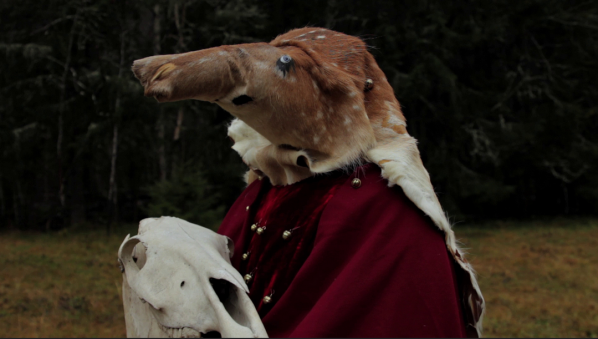
Edward Picot: Can I ask you about the making of the costumes and props for your films?
Ingrid Torvund: I make the costumes and props myself mostly, sometimes I get some help from my friends and family, if it´s large set pieces and so on. I like to take my time making these things, it`s a slow process but it´s one of these things that makes life worth living.
EP: Were you at art school, and if so did you study art, textiles, film or all three?
IT: I went to Oslo National Academy of the Arts,where I took a bachelor degree in fine art. While I was there I made my first short, “Magic Blood Machine“, and I worked on it for three years. I took courses in film, philosophy and many other subjects.
EP: Can you describe your creative process a little bit? Do you start off with an idea for a story, or with sketches in your sketchbook?
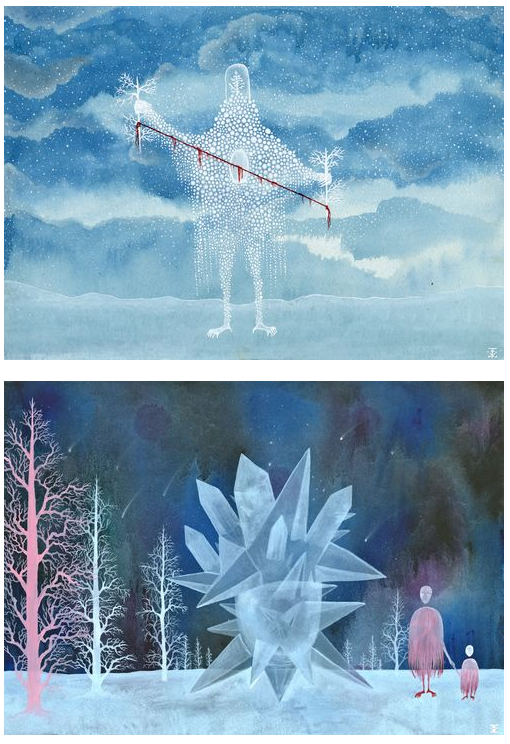
IT: it’s really random how I find inspiration, but sometimes I find a nice tactile material that I want to work with and I start by just trying out how and then I can make something that gives the audience the same feeling I got when I first saw it. And sometimes I get a picture in my head of a scene I want to make and then I try to figure out how to make it, then I draw it (but not very detailed and not very good 🙂
I wish I could say I plan out projects better, but I usually just make what I want to make. Over the years the planning of the filmprojects has become more detailed, but this is because I have to [plan things out] when I apply for funding and it’s a real creative killer.
For the last film “When I Go Out I Bleed Magic” we (me and Jonas) made a long storyboard with many scenes, but in the end we didn’t get to make them all due to lack of funding, lack of time and plain exhaustion.
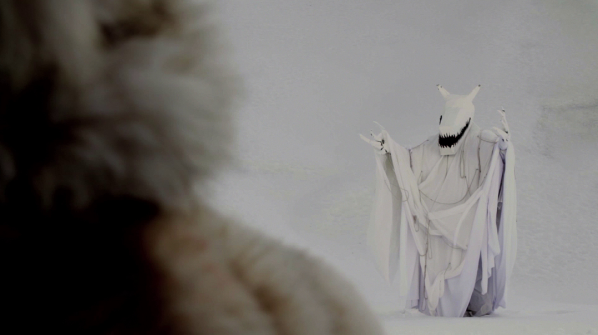
EP: You say you like to take your time making the costumes, props and so forth. Does this mean that your ideas about the film you’re going to make grow quite slowly and organically as you’re in the process of making things?
IT: Yes it does, it’s a long process and I usually try to finish one little part at a time: a costume, a set piece and so forth. But when the time comes to shoot the scene, I have to but all the pieces together, and then I have a time limit. In the two films I’ve made so far I’ve been borrowing my dad’s place, because there I have the space to actually build a little studio in the summer. But since this is his workplace normally, I have to clean it out before they come back from their holiday 🙂 So the summer is a really intense period in the year for me and I have to plan it out more, due to the fact that when I go to work there, I can’t get away, so I must buy all the materials I need before I go. I don’t have a car or a licence and it’s in the countryside. We do have a little boat that I can take to the grocery store 🙂
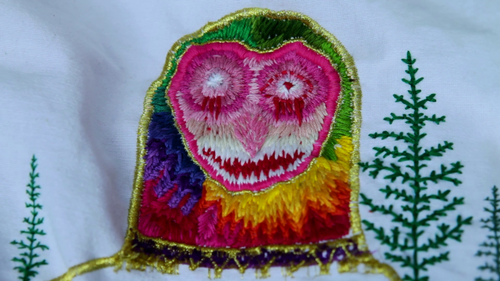
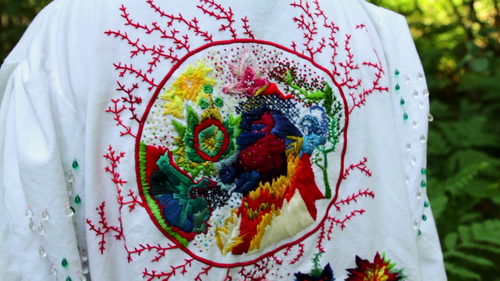

EP: You mention you’ve got a boat – and lo and behold, there’s the red character rowing a boat in Magic Blood Machine. I’m guessing from this that the boat in the film is your own boat, and the lake which appears in both films is the lake where you live.
IT: Yes, most of the places in the movies are from around where I grew up. I also think that it’s important to find inspiration from real and often personal things in life. it feels important to me to know that the project has some kind of root in something real. At my last exhibition my mother gave me some very old school books that I had made some drawings in, and it was almost disturbing how much some of them resembled some of my more current drawings!

EP: Let me ask you about Jonas. How do you work with him? How did you get to know each other and work together, and do you write together, or does he do the camerawork while you put on the costumes and do the acting?
IT: I met Jonas while we were going to an art school in Oslo seven years ago, at the time I was already making characters and installations and we started to date while I was building a forest installation inside a room. He has always had great interest for films and making them, and at that point I was thinking of trying to bring my characters to life by making them into costumes I could wear. After a year we started working on Magic Blood Machine. From that point he has done all the camerawork, while I do all the costumes, set pieces and “acting”. We usually edit the films together and sometimes we make an edit each and then compare them, and choose what we think works the best. I’ve been asked before how we collaborate on these projects and sometimes I find it a little difficult to answer, because we live and work together and we have no rules on who does what in these films. But I do know I spend most of my time thinking or working on these films and Jonas takes part in that if I ask him to. Without him I would not be able to make films like these and my life would suck.
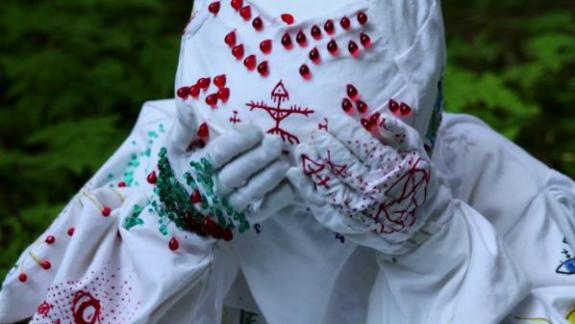
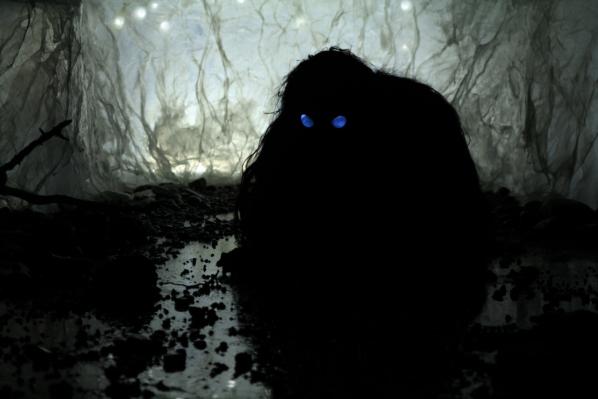
EP: Lastly, would you like to say a bit about the mixture of mythological references in your films?
IT: I have always been fascinated with the mixture of pagan and Christian culture. When I was young I found a book called “Norske Hexeformularer og magiske opskrifter”: it’s a collection of spells and magical recepies from 1600-1900. The spells are collected from small black books found throughout the country, often hidden away. Some would put them under the church steps in an attempt to get rid of them. My films are inspired by these rituals and the conflict between nature and religion. I grew up going to church a lot and I think the mix of church and folklore is something I use as inspiration when I make films.
I think I find the history of how people lived and their traditions even more fascinating then fairy tales, for example people used to think that their newborn babies sometimes got exchanged with a person from under the earth.The child then got some kind of physical change,like a weird growth or huge eyes or it suddenly looks very old. The only way to fix it was to lure the under earth person to tell you their real age. You did this by doing weird and absurd stuff, like making porridge in an eggshell or making blood sausage in an catskin. Then it would suddenly tell you how old it was and then it would die. Leaving a little lump of ash and bones…
More information about Ingrid Torvund can be found on her website, http://torvund.tumblr.com/. Magic Blood Machine is on Vimeo at https://vimeo.com/44936472, and When I Go Out I Bleed Magic is also on Vimeo, at https://vimeo.com/44936472.
Featured image: “Binoculars” at CHB in Berlin (2013)
Varvara Guljajeva & Mar Canet have been working together as an artist duo since 2009. They have exhibited their art pieces in a number of international shows and festivals. As an artist duo they locate thermselves in the fields of art and technology, and are interested in new forms of art and innovation, which includes the application of knitting digital fabrication. They use and challenge technology in order to explore novel concepts in art and design. Hence, research is an integral part of their creative practice. In addition to kinetic and interactive installations, the artists have also experience with working in public spaces and with urban media.
Varvara is originally from Estonia, and gained her bachelor degree in IT from Estonian IT College, and a masters degree in digital media from ISNM in Germany and currently is a PhD candidate at the Estonian Art Academy in the department of Art and Design. Mar (born in Barcelona) has two degrees: in art and design from ESDI in Barcelona and in computer game development from University Central Lancashire in UK. He is also a co-founder of Derivart and Lummo.
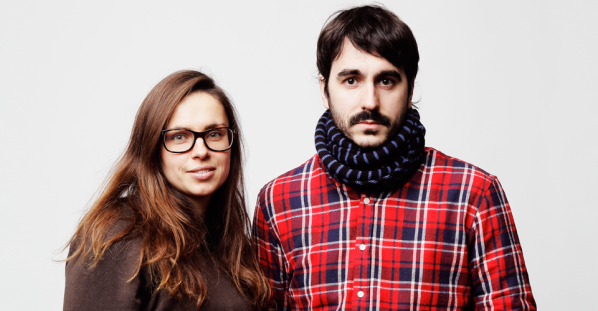
Filippo Lorenzin: Open culture is one of the main points of your research and activity. Could you describe how this influences your art practice?
Varvara & Mar: We are living in very exciting times. Open source has introduced democratization of production and creation. Now you can build your own 3D printer, laser cutter, knitting machine, make a light dimmer circuit or develop a body tracking system. Some years ago we couldn’t even imagine this and now we have access to this knowledge. People share their creations and these process, which is incredibly inspiring for us and many more people. Thus, knowledge is built on top of knowledge. We make use of open source marterial in our work and we try also to contribute back. This is the whole point of open source in our mind. And if one looks in the perspective of art to open source projects, then really many open source projects have artists on board, for example, OpenFrameworks, Processing, and more.
Open source also has an educational aspec. We do many workshops with people and teach what we know and how we work. We think open source culture is largely based on the spirit being open to sharing knowledge with many others.
FL: I’m really fascinated by your interest in textile fabrication. it reminds me the early industrial developments that were deeply connected to in the textiles industry. How and why would knitting be integrated these days as part of a makers’ culture?

V&M: The process of integration is well under way. There has been a good number of makerspaces who have dedicated areas for textile production, like WeMake in Milan and STPLN in Malmö. And believe it or not this simple thing helps to introduce gender balance in these kind of places. We’re not just talking about innovation, which can boost gender equality when you introduce knitting to hacking. We’re also talking about the democratisation of production, when thinking about clothing too. This area is quite vital and commonly understood. 3D printing toys is a cool activity for a weekend, but then it becomes boring. Knitting a sweater or a scarf has real value and the quality is always higher than a typical mass produced factory product.
For 3D printing we cannot say the same. Don’t get us wrong, we are not against the 3D printing. We love it and have six printers in our studio. Our point is that the areas of concern for digital fabrication are not complete, and the founders of FabLab have overlooked the whole area of textiles.
FL: You’ve run many workshops taking in account various topics such as 3D printing, solar energy and knitting, of course. How do these activities connect with your research?
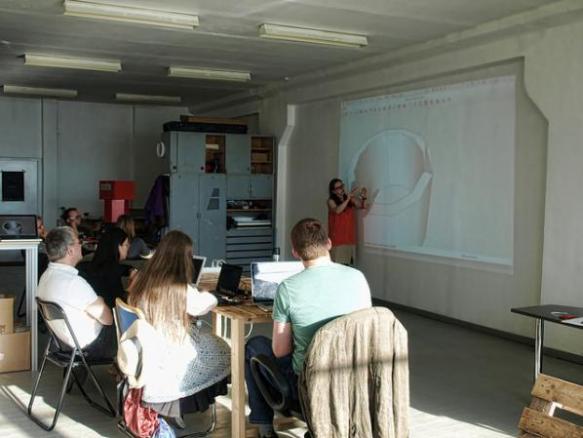
V&M: First of all, we like to teach and interact with our students. Second, preparing a workshop, allows us to research more about the field, and organise and share our accumulated knowledge and experience.
And finally, workshops are one part of our income. We don’t have any other jobs on the side, and exhibitions and commissions are not regular and do not always pay well, and yet the bills keep coming in. Hence, workshops help us to pay our bills.
FL: One of your works which most fascinate me is “Sonima” (2010). It’s a project that takes in account questions that have become quite recurrent in last months, mostly linked to Anthropocene discussions. The soft coexistence of technology and nature which is organic and artifical. Which is one of the main topics of your research: why are you so interested in this question? It looks like you’re trying to develop experiments for an utopistic future in which humans and nature live in symbiosis. Am I wrong?
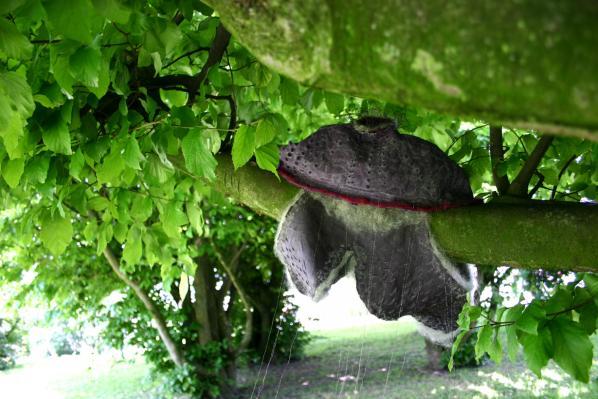
V&M: Yes, many of our works express our futuristic thoughts or imagination where the digital age will lead us and our planet to. It is nice that you have noticed this. I would say this kind of concept in 2010 was quite subconscious. I (Varvara) was very interested in organic form but with mutational origins but still adapted by nature.
More conscious approach towards anthropocene epoch can be seen and felt in “Tree of Hands” (2015), which is one of our recent works. However, it looks like we have touched quite a taboo topic. For instance, “Tree of Hands” was rejected by jury of PAD London fair because of its depressive concept.
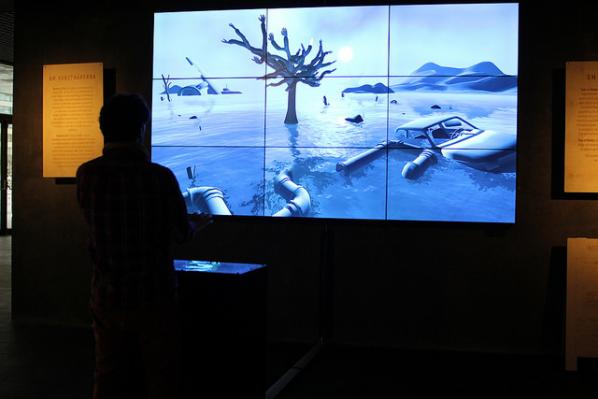
FL: “Shopping in 1 Minute” (2011) is another project I would like to ask you about. This work is about consumerism at its finest (or worst), turning one of the most typical capitalistic places (supermarkets) into ludic spaces. It’s a piece of social art that presents itself without informing the public what is right and what is wrong, but it rather suggests in a more subtle way the perversion at the base of that system. What do you think?
V&M: Yes. What we are doing is the absurd exaggeration of the same action (buying) to a maximum with one but: not buying and playing instead. There is a saying that shopping is 5 min happiness. The artwork tries to create a synthetic feeling of satisfaction of the ability to buy. The shopping centers are doing everything to stimulate our consumption needs, and our artwork manages to get inside their ecosystem and playfully releases that artificial desire to buy.
FL: With at least a couple of projects, you’ve also worked to the redefine hurban landscapes by looking at the invisble while at the same time taking on rather specific forces such as mass use of Wi-Fi networks becoming part of the everyday. I can’t help thinking that this is somehow related to privacy questions, probably because one of the most notorious scandals some years ago was Google’s secret recording of Wi-Fi networks with their Street View cars. Am I wrong?
V&M: Not really. But definitely Google has played a role in feeing our concerns about being watched, spied, hacked, scanned, etc. For example, the last scan for WiFi router names we did last summer in Tallinn some people were quite freaked out seeing a person on a bike with a camera on its head and tablet in front. I was even once asked if I worked for Google. 🙂 Anyways, the project was great fun for us, and we got to explore the city and discover the whole invisible communications networks and the self expressive layers of it all. After the Tallinn scan we even changed our minds about the 32-character local Twitter that the WiFi router SSID could be used for. The Tallinn experience showed us the new tendency: where people would use radio waves for semi-anonymous graffiti, communicating sometimes silly, protective, racist or political messages.
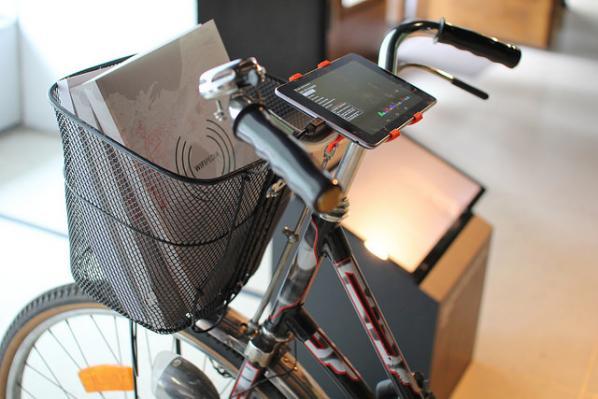
Talking about inspiration for this project, we got our interest for WiFi names from one article talking about the ability to track down pro- and contra-Obama communities by just looking at WiFi names in the neighborhood. This was before the US president election. Then we started to thinking of an art project on this topic.
FL: “The Rythm of City” (2011) is another project which is also ‘subtly’ related to control issues. The idea that someone can depict the state of a city by looking at data deducted from social media and web platforms. This type of thing is real now isn’t it – what do you think?

V&M: Definitely it is. However, the work’s main intention is not to talk about control issues rather about big data and its applications. Perhaps the main intention of this work is to offer to the viewer(s) a birds eye view on different cities in real time. In other words, The Rhythm of City allows you to zoom out and witness the larger picture on the current situation. And this larger picture is formed by everybody’s activity on social media, which is tracked down every minute. We call this action ‘unaware participation’ by digital inhabitants. The urban studies of Bornstein & Bornstein from early 1970s served as an inspiration for this artwork. They had discovered a positive correlation between the walking speed of pedestrians and the size of a city. Simply put: the bigger a city, the faster people move. The artwork demonstrates our interpretation of a city’s tempo through in its digital form or life. Hence, The artwork talks about pace of life in different cities at the same moment when the piece is viewed.
FL: What have you been working on these last few months and what plans do you have for 2016?
V&M: We are working on a series of new works talking about money. When we have completed “Wishing Wall” in London in 2014, since then we have noticed that the majority of people, especially a younger audience, wish for money. This really caught our attention. The ongoing hard economical situation in Europe pushes forward the need for money and also introduces a growing gap between the economical classes. So we’re investigating people’s desire for money and its connection with happiness. Making use of interactive technology we are aiming to approach playfully and magically the desire for becoming rich. At the same time, we cannot let go of knitting. At present, we are working on an open source flat knitting machine, which will be able to knit patterns also. Besides the new productions, we are showing our existing works in various exhibitions. For the confirmed ones, “The Rhythm of City” will be part of “REAL-TIME” a group show curated by Pau Waelder in Santa Monica museum in Barcelona from the 28th January. In February “Digital Revolution” (the touring exhibition by Barbican), which “Wishing Wall” is part of, moves from Onassis Cultural Center in Athens to Zorlu Center in Istanbul. And hopefully we get couple of other shows and new productions that are in the air at the moment and still to be confirmed soon.
French artists Émilie Brout and Maxime Marion contribute three pieces to The Human Face of Cryptoeconomies exhibition. Gold and Glitter is a painstakingly assembled installation of collaged GIFs. Previous installations have featured the GIFs displayed on a gold iPad atop a pile of collected gold trinkets; at Furtherfield Gallery now a single golden helium balloon hovers in front of a floor to ceiling projection. Nakamoto (The Proof) is video documentation of the artists’ efforts to try and place a face on the elusive Bitcoin creator, Satoshi Nakamoto (but is it his face in the end? We don’t know). Untitled SAS is a registered French company without employees and whose sole purpose is to exist as a work of art.
Brout and Marion’s work can be situated among artists and art practices who have grappled with how to think about value and objects—or more precisely, how objects are inscribed (and sometimes not) into an idea of what is valuable. In a recent article for Mute Magazine, authors Daniel Spaulding and Nicole Demby point out that “Value is a specific social relation that causes the products of labor to appear and to exchange as equivalents; it is not an all-penetrating miasma.”1 Value is a process by which bodies are sorted and edited but it is not a default spectrum on to which all bodies must fall in varying degrees. This clarification makes explicit the fact that while the relationships productive of value allow “products of labor to appear and to [be exchanged]”2 this is not an effect that is extended to all products of labor. Attempts to isolate the underlying logic of this sorting mechanism are often at the heart of art practices dealing with questions of value and commodification. Like Andy Warhol’s Brillo Boxes or Marcel Duchamp’s Fountain, these artworks become interesting problematics for the question of art and value for the ways in which they are able to straddle two economic realms—that of the art object and the commercial object—while resisting total inclusion in either.
The Human Face of Cryptoeconomies picks up these themes in an art context and repositions them alongside digital cultures and emerging digital economies. In Brout and Marion’s work alone, concepts of kitsch, identity, and human capital have been inhabited and imported from their originary realms into the digital. Answering questions remotely, Brout and Marion were kind enough to give us some insights into their work and process. My goal here has been to draw out some points about the operation of value that are at work in Brout and Marion’s practice, as well as to point towards an idea of how value is transformed, or even mutated, in the digital age.
* * *
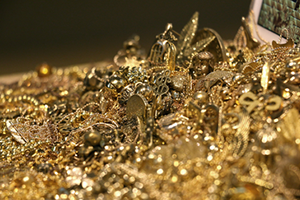
Brout and Marion open up with an interesting provocation. They explain, “When we showed the project [Glitter and Gold] in Paris this year, people stole a lot of objects, even if they were very cheap. Gold has an incredible power of attraction.”
It is telling, to some extent, that Brout and Marion’s meditations on gold have an almost direct link to the visual metaphor used by Clement Greenberg in his 1939 essay Avante-Garde and Kitsch to describe the relation between culture—epitomized in the avant-garde—and the ruling class. Greenberg writes, “No culture can develop without a social basis, without a source of stable income. And in the case of the avant-garde, this was provided by an elite among the ruling class of that society from which it assumed itself to be cut off, but to which it has always remained attached by an umbilical cord of gold.”3 This relation is subverted in Gold and Glitter, which takes for its currency—its umbilical cord of gold—a kind of unquantifiable labor that is seemingly (and perhaps somewhat sinisterly) always embedded in discussions of the digital.
For Greenberg, kitsch always existed in relation to the avant-garde; one fed and supported the other, even if the way in which that relation of sustenance worked was by negation. And while Greenberg’s theory relies on his own strict allegiances to hierarchical society, privileged classes, the values of private property, and all the other divisive tenets of capitalism that we now know all too well can be destructive. Kitsch remains useful to us for the ways in which it allows the means of production to enter into a consideration of aesthetics. Here the recent writing of Boris Groys can be useful. In an essay written for e-flux titled Art and Money, Groys makes a compelling case for why we should persist in a sympathetic reading of Greenberg. He argues that Greenberg’s incisions amongst the haves and have nots of culture can be cut across different lines; that because Greenberg identifies avant-garde art as art that is invested in demonstrating the way in which is it is made and it doesn’t allow for its evaluation by taste. Avant-garde art shows its guts to us all, and on equal terms—“its productive side, its poetics, the devices and practices that bring it into being” and inasmuch “should be analyzed according the same criteria as objects like cars, trains, or planes.”4
For Groys this distinction situates the avant-garde within a constructivist and productivist context, opening up artworks themselves to be appreciated for their production, or rather, “in terms that refer more to the activities of scientists and workers than to the lifestyle of the leisure class.”5 In this way Glitter and Gold, like Brout and Marion’s other artworks, is to be appreciated not for any transcendent reason but rather for the means by which it came into existence. ‘The processes of searching and collaging golden GIFs sit side by side with the physical work of accumulating the golden trinkets for display: “We collected these objects for a long time” the artists explain, “some were personal objects (child dolphin pendant, in true gold), others were given or found in flea markets, bought in bazaars … We wanted to have a lot of different types and symbols, from a Hand of Fatima to golden chain, skulls, butterflies, etc.”
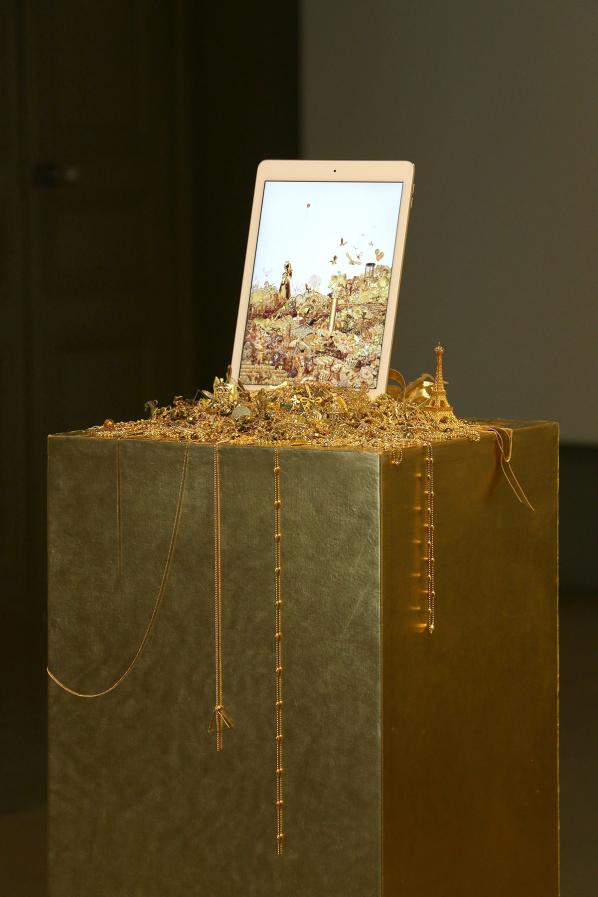
Furthermore, Glitter and Gold can be understood as the product of compounding labors: the labor of Brout and Marion in collecting their artifacts, the labor necessary to create the artifacts, the labor of GIF artists, the labor of searching for said GIFs, the labor of weaving a digital collage. These on-going processes forge, trace, and re-trace paths during which, at some point, gold takes on the function as aesthetic shorthand for value. As Brout and Marion explain, “Here the question is more about the intrinsic values we all find in Gold, even when it just looks like gold. Gold turns any prosaic product into something desirable. [Gold and Glitter] is less about economics than about perceived value.”
Groys provides his reading of Greenberg as a means of pointing towards a materiality that is always in excess of existing coordinates of value. If value always reveals the products of labor as they enter into a zone of exchange, it is something else proper to contemporary art that reveals another materiality beyond this exchange. For Groys, this something else is at work in the dynamics of art exhibition, which can render visible otherwise invisible forces and their material substrates. This is certainly a potential that is explored by Brout and Marion. In Nakamoto (The Proof), the viewer can watch the artists’ attempt at creating a passport for the infamous and elusive Bitcoin creator Satoshi Nakamoto. At present, it is unclear whether Nakamoto is a single person or group of people, though the Nakamoto legacy as creator of Bitcoin, a virtual currency widely used on darknets, is larger than life. Adding to this myth, after publishing the paper to kickstart bitcoin via the Cryptography Mailing List in 2008, and launching the Bitcoin software client in 2009, Nakamoto has only sporadically been seen participating in the project with others via mailing lists before making a final, formal disappearance in 2011, explaining that he/she/they had “moved on to other things.”6 Nakamoto’s disappearance, coupled with the fact that Nakamoto’s estimated net worth must be somewhere in the hundred millions Euros, has given rise to the modern-day myth of Nakamoto, and with it an insatiable curiosity to uncover the identity and whereabouts of the elusive Bitcoin creator.
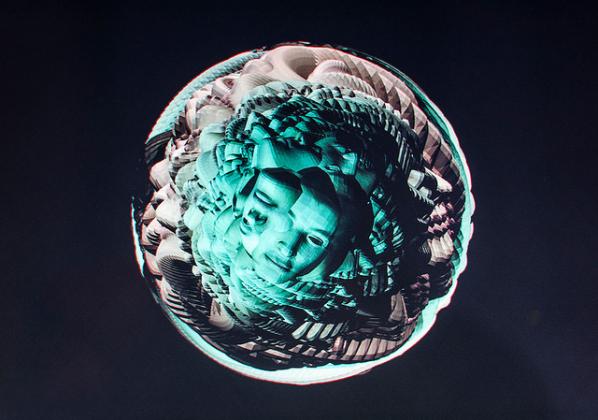
Brout and Marion make their own attempt to summons the mysterious Nakamoto back to life by putting together the evidence of Nakamoto’s existence and procuring a Japanese passport using none other than the technologies that Nakamoto’s Bitcoin both imparted and facilitated. When asked if they feared for their own self-preservation in seeing this project through, Brout and Marion answered, “Yes, even if we were pretty sure that it would be easy to prove our intention to the authorities, and that the fake passport couldn’t be useful to anybody, buying a fake passport is still illegal.” They add, “But we also wanted to play the game entirely, so we made every possible effort to preserve our anonymity during our journey on the darknets.”
However Brout and Marion have yet to receive the passport; as they explain, “The last time we received information, the document was in transit at the Romanian border.” When asked if they expect to receive the passport, they respond, “No, today we think we will never receive it. We are completely sure that it has existed, but we’ll surely never know what happened to it.” What, then, will they do if they never receive the passport? “Maybe just continue to exhibit the only proof of it we have!” they exclaim. “There is something beautiful in it: we tried to create a physical proof of the existence of a contemporary myth, using digital technology and digital money, and the only thing we have is a scan!”
If Brout and Marion’s nonchalance seems unexpected then it is because the disappearance of the passport for the artists marks just another ebb in the overall flow of their piece; a flow that began with Nakamoto, coursed through their clandestine chats via a Tor networked browser and high security email, and now continues to trickle on while we wait in anticipation for the next chapter of the Nakamoto passport to reveal itself. In this respect, the anticipation of the passport is a poetic and unforeseen layer added to the significance of the piece: “Maybe it is even better [that the passport should not arrive]” Brout and Marion comment. “It’s like it was impossible to bring Nakamoto out of the digital world.”
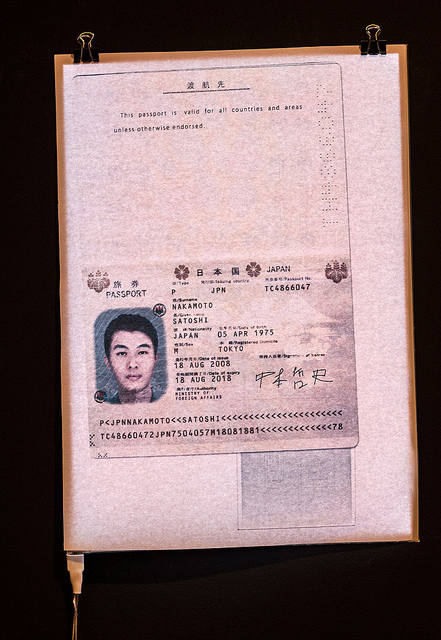
If value is always formed by way of a social relation, then how do digital modes of sociality also deliver this effect? This becomes a particularly fraught question when considering that, as Anna Munster has written, the sociality that takes place on the internet can be understood as the interrelation of any number of subjectivities, both organic and inorganic. Brout and Marion’s ambivalence to the purloined passport highlights just such an expectation: “Here the lack of identity delivers a lot of value. Look at Snowden: journalists ask him more about his girlfriend than about his revelations. Making something as big as Bitcoin and staying perfectly anonymous? These are strong attacks to two of the most important issues of our societies: banks and privacy.” What their statement suggests is how a collective movement towards transgression, here seen as compounding maneuvers of avoidance of physical world boundaries and institutions, might hold within it the promise of its own set of value coordinates. As Brout and Marion further explain: “For us, Nakamoto is absolutely fascinating. The efforts he made to prevent himself from being turned into a product are incredible. Especially when you know the importance of [Bitcoin’s] creation, and that only a few men in the world are smart enough to create something like this. Adding to that the fact that Nakamoto is probably a millionaire, you have one of the only true contemporary myths, something hard to find credible even if it was just a fictional character in a movie. So this somewhat absurd attempt to create a proof of Nakamoto’s existence was, for us, an attempt to make a portrait of him, to put light on his figure. And, in some ways, a tribute.”
Brout and Marion mount a final probe into questions of value in their piece, Untitled SAS. Untitled SAS is the name for Brout and Marion’s corporation whose purpose and medium is to exist as a work of art. In France SAS means société par actions simplifée, and is the Anglophone equivalent of an LTD. SAS companies have shares that can be freely traded between shareholders. Untitled SAS, in Brout and Marion’s own words, “has no other purpose than to be a work of art: it won’t buy or sell anything, there won’t be employees, its existence is an end it itself. The share capital of the company is 1 Euro (the minimum), and we edited 10,000 shares owned by us (5,000 for each one). Everybody can freely buy and sell shares of this company.” Brout and Marion are clear: in no uncertain terms, “Untitled SAS is a work of art where the medium is a real company, and the corporate purpose of this company is simply to be a work of art.”
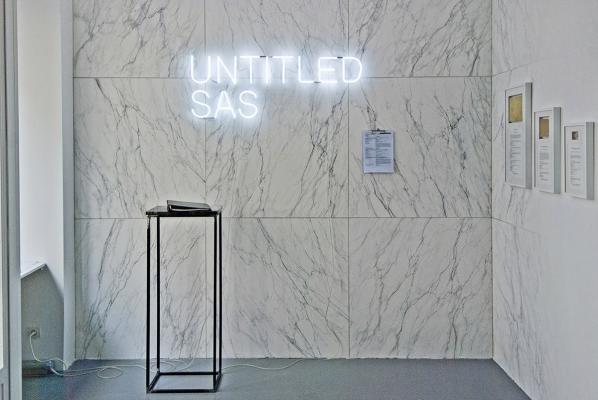
Untitled SAS is a tongue in cheek commentary on the situating of artworks as outside of the rational space of the market while still being subject to selective norms of economic behavior. Brout and Marion explain, “Untitled SASis obviously a metaphor for the art market, and the market in general: it is a true, fully legal, and functional speculation bubble. Companies usually try to create some concrete value, they are means. The art world has fewer rules than the regular market, the price of some artworks can radically change in few days without any logical reason: their intrinsic value is completely uncorrelated to their market value. We wanted to reproduce and play with these systems in the scale of an artwork.” At this level, what Brout and Marion uncover is further proof of the condition of the contemporary art period as Groys sees it: a time in which “mass artistic production [follows] an era of mass art consumption” and by extension “means that today’s artist lives and works primarily among art producers—not among art consumers.”7
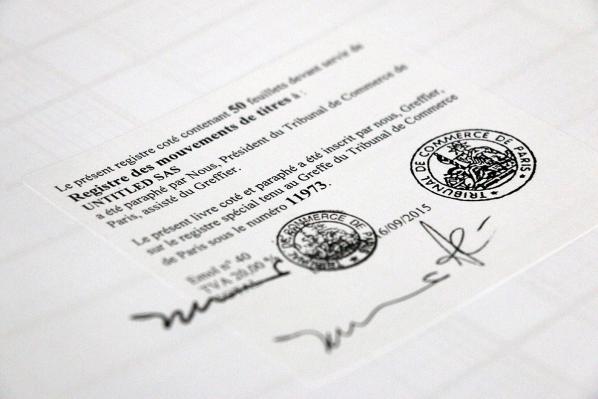
Crucially, the effect of this condition is that contemporary professional artists “investigate and manifest mass art production, not elitist or mass art consumption.” This is the mode of art making precisely employed by Brout and Marion in the creation of Untitled SAS. It has the added effect, too, of creating an artwork that can exist outside the problem of taste and aesthetic attitude. Companies tend to eschew taste qualifications in favor of brand associations. Untitled SAS becomes readable as an artwork, as Untitled SAS, when the expectations and regulations of a nationally recognized business are made to butt up against the inconsistencies of the artworld as an economic sphere. The art object then becomes rather a means of accessing the overlapping paths of art and value as they are uniquely enabled to circulate in and out of the art & Capitalist markets.
* * *
Brout and Marion note that, “In our work we often use algorithms and generative ways to produce things, but here we wanted to something no machine can do, something hand-made, too, finally a simple and traditional work of art.” These kinds of generative technological processes and sorting algorithms have been central to many debates on how contemporary culture is absorbing the boon of big data: from ethical questions on predictive policing to dating apps and ride-hailing startups. As one Slate article posed the question in relation to Uber, these algorithms are more than just quick and efficient modes of labor—they are reflections of the marketplace themselves.
So what, then, might it mean that both values and services in the digital age are predicated on the power to sort and categorize, and that this power is ciphered through its own dynamic of social relations, but that in one scenario what emerges is a sphere of the valuable and in the other a software that asserts itself as benign and at the behest of an impartial, impersonal data? Perhaps the rationality of value and market circulation vis a vis the art object was always going to be a little too tricky to take on: too many exceptions, too many questions of subjectivity, taste, and judgment. But as the works exhibited for The Human Face of Cryptoeconomies might suggest the rationality of value and the products it chooses to incorporate is of high importance. If value works precisely because of the specific interrelating of social subjects then we can consider the realm of the digital as a concentrated form of such a relation.
Against this we must consider the new subject that is produced and addressed by the intersecting of these discussions. Spaulding and Demby make the case that, that “Art under capitalism is a good model of the freedom that posits the subject as an abstract bundle of legal rights assuring formal equality while ignoring a material reality determined by other forms of systematic inequality.”8 Karen Gregory, in The Datalogical Turn, writes, “In the case of personal data, it is not the details of that data or a single digital trail that are important, it is rather the relationship of the emergent attitudes of digital trails en mass that allow for both the broadly sweeping and the particularised modes of affective measure and control. Big data doesn’t care about ‘you’ so much as the bits of seemingly random information that bodies generate or that they leave as a data trail”.
The works of Brout and Marion exhibited at the Human Face of Crypotoeconomies exhibition places the intimacy of the body front and center. They speak to the shadow and trace of the body by appropriating the paths of the faceless, or by giving a face to the man (or entity) without a body, to becoming the human face of the market player par excellence by inserting themselves into a solipsistic art corporation. Brout and Marion’s practice understands that while value may not be an all-penetrating miasma, this is not also to say that the effect of value is not still inscribed on the flesh of each and all, organic or not.
1 Demby, “Art, Value, and the Freedom Fetish | Mute.”
2 Ibid.
3 Greenberg, “Avant-Garde and Kitsch,” 543.
4 Ibid.
5 Ibid.
6 “Who Is Satoshi Nakamoto?”
7 Groys, “Art and Money.”
8 Ibid.
Stanza is an internationally recognised artist who has been exhibiting worldwide since 1984. He has won so many prizes you’d have trouble fitting them all on one mantlepiece. He has exhibited over fifty exhibitions globally and is an expert in arts technology, CCTV, online networks, touch screens, environmental sensors, and interaction. His artworks examine artistic and technical perspectives, within the contexts of architecture, data spaces and online environments.
Recurring themes throughout his career include the urban landscape, surveillance culture, privacy and alienation in the city. Stanza is interested in the patterns we leave behind, and real time networked events, that are usually re-imagined and sourced for information. He uses multiple new technologies so to create distances between real time, multi point perspectives that emphasis a new visual space. The purpose of this is to communicate feelings and emotions that we encounter daily which impact on our lives and which are outside our control.
Much of his work has centered on the idea of the city as a display system and various projects have been made using live data, the use of live data in architectural space, and how it can be made into meaningful representations. See Publicity, Robotica, Sensity, as well as a whole series of work manipulating real time CCTV data to making artworks with them: See, Velocity, Authenticity, Urban Generation. These works reform the data, work with the idea of bringing data from outside into the inside, and then present it back out again in open ended systems where the public is often engaged in or directly embedded in the artwork. Interactive and visually appealing, his style also maintains the substantive power through multi-facetted content.
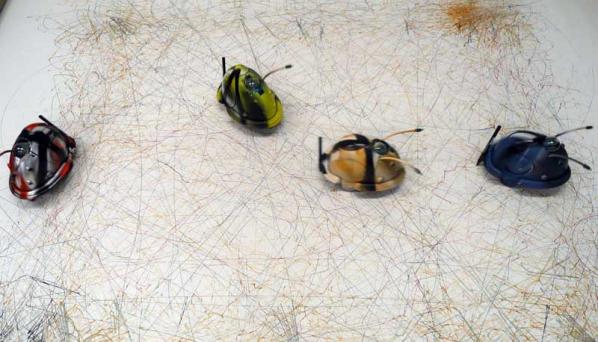
Marc Garrett: Could you tell us who has inspired you the most in your work and why?
Stanza: I don’t really get inspiration from the “who” question, I prefer the “what” and “why” questions. As a professional artist I look at loads of art so to understand what art is and can be, and it’s always an ever changing and fluid response. I also spend a lot of time ignoring stuff and material; (focused ignoring) because it has become harder and harder to see though the fog; the noise of it all. Maybe it’s better to think of a working model for inspiration, Andy Warhol had one. Just make the work. That’s what I do. I am not a part time artist in academia or an artist with another job, I’ve done this for the last thirty years, inspired by and in response to the world around me.
This dogmatic commitment to my work comes from my believes that the system you have to trust and invest in yourself. Inspiration, quite literally is everything all around you all at once, all at the same time, moment by moment. This is what inspires my work and it influences the creation of real time information flows, and works in parallel realities. It allows me to stand back at a distance and work with complex data sets while at the same time making meaning from them. Forming data into a shape, because this confluence might inspire a repositioning of thought and values while at the same time unlocking a hidden meaning to enable the viewer to feel and experience something new or to do something creative with the results.
MG: How have they influenced your own practice and could you share with us some examples?
S: There’s a saying be careful what you wish for. If one reverses this then it could be wish for what you want and need. Influence is problematic because it’s both negative and positive. The idea of influence seems causal, but my own practise isn’t based on influence but in research into certain themes. This enables me to get into both sides of particular questions or debate, so to frame the work I make. Works like these have been inspired by this focus…
The Singing Trees, focus in the invisible things and the environment http://stanza.co.uk/tree/index.html
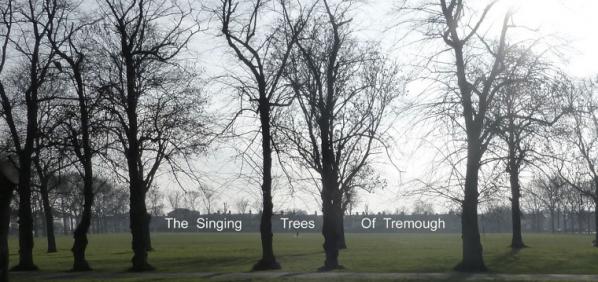
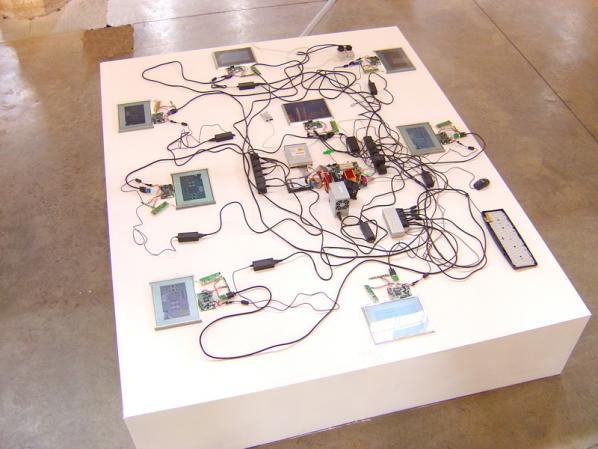
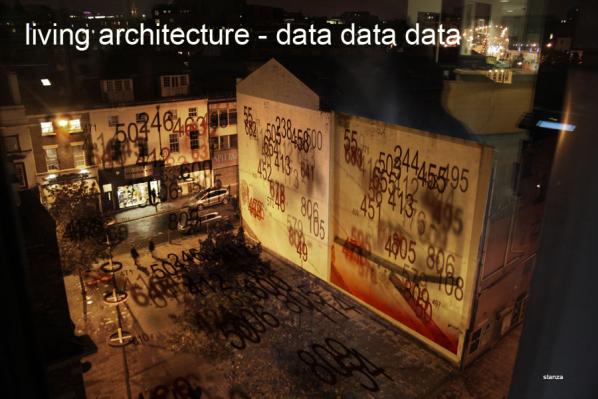
MG: How different is your work from your influences and what are the reasons for this?
S: I have been researching smart cites, urbanisn, and have collected ‘big data’ since 2004. I have been building my own wireless sensor network. This eventually manifested itself in an artwork called Capacities in 2010 which then influenced all the others in the series until it now has this form.
Capacities: Life In The Emergent City, captures the changes over time in the environment (city) and represents the changing life and complexity of space as an emergent artwork
http://stanza.co.uk/capacities/index.html
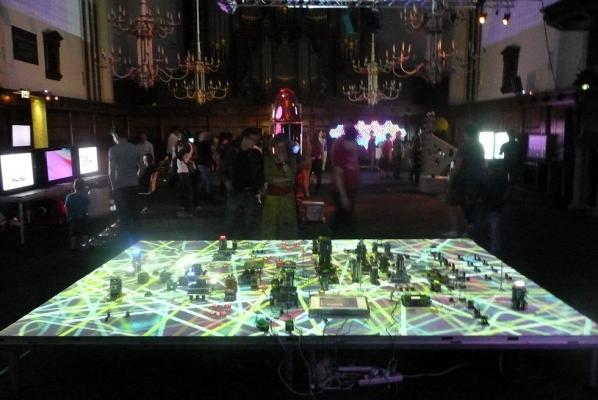
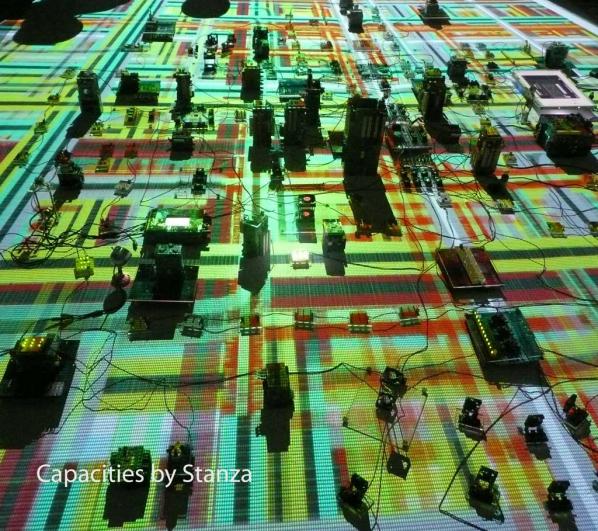
Which led to…
The Nemesis Machine- From Metropolis to Megalopolis to Ecumenopolis.
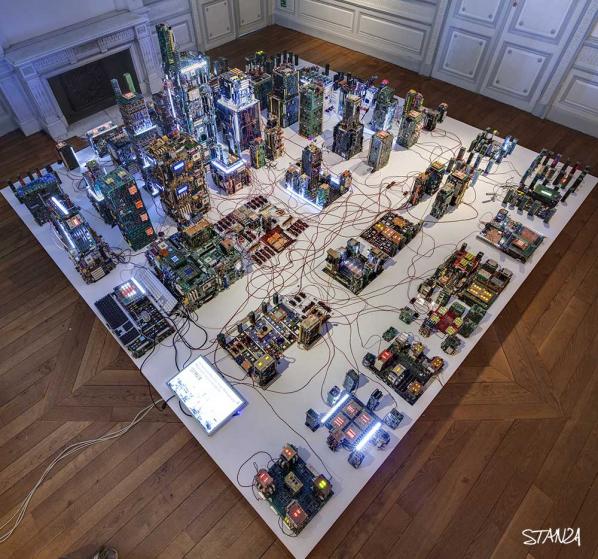
“A Mini, Mechanical Metropolis Runs On Real-Time Urban Data. The artwork captures the changes over time in the environment (city) and represents the changing life and complexity of space as an emergent artwork. The artwork explores new ways of thinking about life, emergence and interaction within public space. The project uses environmental monitoring technologies and security based technologies, to question audiences’ experiences of real time events and create visualizations of life as it unfolds. The installation goes beyond simple single user interaction to monitor and survey in real time the whole city and entirely represent the complexities of the real time city as a shifting morphing complex system.
The data and their interactions – that is, the events occurring in the environment that surrounds and envelops the installation – are translated into the force that brings the electronic city to life by causing movement and change – that is, new events and actions – to occur. In this way the city performs itself in real time through its physical avatar or electronic double: The city performs itself through an-other city. Cause and effect become apparent in a discreet, intuitive manner, when certain events that occur in the real city cause certain other events to occur in its completely different, but seamlessly incorporated, double. The avatar city is not only controlled by the real city in terms of its function and operation, but also utterly dependent upon it for its existence.”
MG: Is there something you’d like to change in the art world, or in fields of art, technology and social change; if so, what would it be?
S: It’s the museum I would like to change or engage with. It seems that anything and everything will end up in the museum. We have become the museum. We are the sum of our collections catalogs and archives. Since the current trend is for public engagement we will see a mix of these new technologies aiding and abetting this and various dialogues.
Therefore these questions need to be raised more vocally. How do visitors interact with each other and artworks? How do visitors behave in public space and what patterns or communities do they form. Can these outputs reshape our experience of public space and the art?
So, new immersive technologies could be used to investigate how visitors interact with art works, with each other and what impact their experiences have in forming new user interactions within public space. This space could be made more social and lead to new real time artworks based on visitor interaction and new visualizations of the gallery space based on gathered data.
Artists used to occupy specific issues but now there aren’t many topics artists haven’t engaged in or reached out to. The issues that will resonate will be the ones closest to the issue of the day…. and, they will be economics, the environment and migration. Because of this I would like to less focus on public engagement spectacle or entertainment and more on the quality and public engagement rooted in intellectual rigour.
Technology affords new ways of working with audiences and curators as participants in artworks. The concept of the exhibition as an active site for experimentation and collaboration between curators, artists and audiences prefigures a general cultural movement towards the centrality of experience and away from the reification of the object.
However, how audience activities and movements can be used as the subject of new artwork as well as modify engagement with existing collections is a cultural and technological challenge.
SeePublic Domain: You Are My Property, My Data, My Art, My Love.

The Public Domain Series involves using live CCTV systems that are already installed then using these cameras to enhance gallery space and the audiences experience of the gallery. http://stanza.co.uk/public_domain_outside/index.html
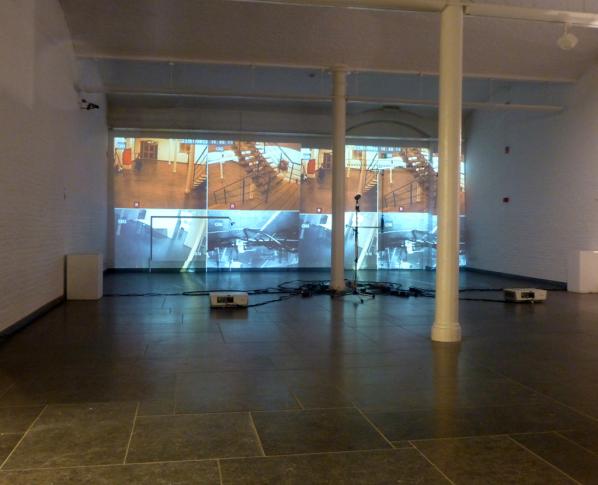
Visitors to a Gallery – referential self, embedded. Stanza uses a live CCTV system inside an art gallery to create a responsive mediated architecture. Anyone in any of the galleries and all spaces in the building can appear inside the artwork at any time.
http://stanza.co.uk/cctv_web/index.html
The social challenge within urban space is one I like to play with. In The Binary Graffiti Club, is a project I set up to try and work in this area. The Binary Graffiti Club are invited members of the public at each location for each event; they are given the hoodie to keep as thanks for their participation and contribution. The Binary Graffiti Club set off across the city and create artworks.
http://stanza.co.uk/binary_club/index.html
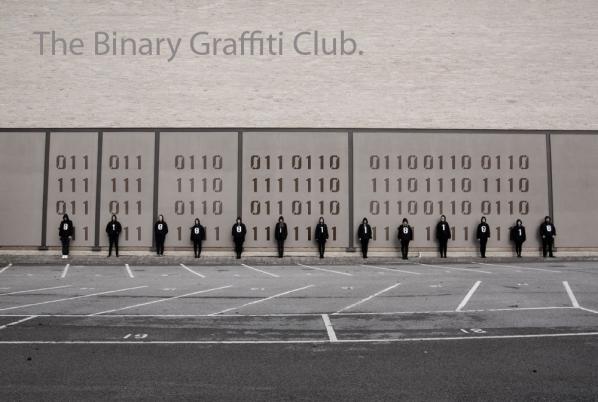
“Youths dressed in black hoodies swarmed the historic city streets of Lincoln during Frequency Festival 2013, their backs emblazoned with bold white digits, the zeros and ones. Their ominous presence was marked with a series of binary code graff-tags on official buildings throughout the city; messages of insurrection for a digital cult now active among us or analogue reminders of the digital soup of signals we wade through on a daily basis? There’s an engaging playfulness and an aesthetic pleasure to Stanza’s work that pays rewards on deeper investigation. His urban interventions remind us of the invisible occupation of the cyberspace around us and encourages us to ask whose hand manipulates these systems of control.” Barry Hale, Festival Co-Director of Frequency Festival 2013: Stanza: Timescapes/Binary Graffiti Club.
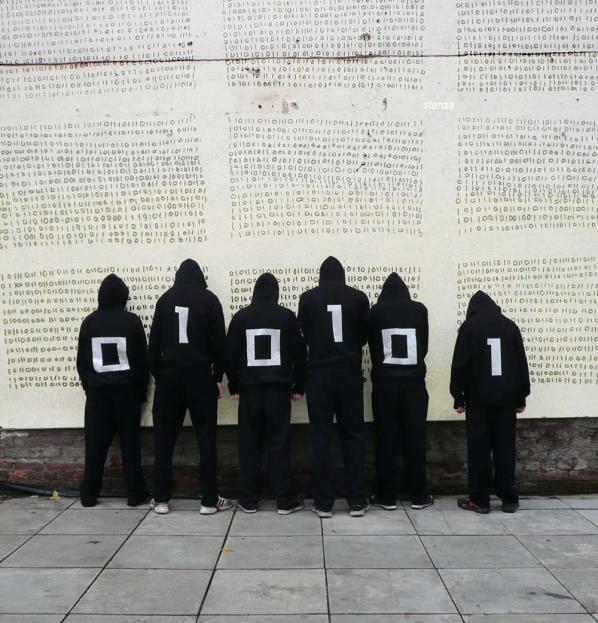
MG: Describe a real-life situation that inspired you and then describe a current idea or art work that has inspired you?
The invention of the toothpaste tube caused a revolution in painting.
The greatest discovery of the age was that the world is full of atoms.
Doing many small things instead one on big thing.
We seam to victimise out children we give them ASBO’S and anti social behaviour orders. For a while I wanted one. They actually give you a certificate like rockers, mods punks etc. The hoodie is a symbol of youth culture as well as being anti social. My new artwork the Reader and the idea of reading books and being anti-social led to this project.
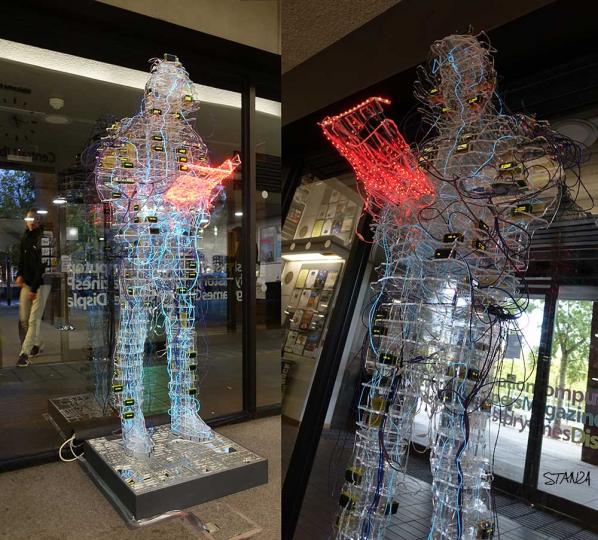
The Reader is a large six foot sculpture of the artist Stanza wearing a hoodie reading a book. The artwork is a metaphor for the engagement of reading in the digital age. The sculpture acts as a focal point for community and public engagement and has taken over one year to make and design; it has been commissioned to act as a focal point for the identity of the library. The reader reads all the books published since 1953 inside a data body sculpture. http://stanza.co.uk/TheReader_web/
MG: What’s the best piece of advice you can give to anyone thinking of starting up in the fields of art, technology and or social change?
S: Make work, make more work, and remember nothing lasts forever except true love.
Re: Art, Study it
Re: Technology. Learn it
Re: Social change . Be part of it.
MG: Finally, could you recommend any reading materials or exhibitions past or present that you think would be great for the readers to view, and if so why?
Yes the Books…
The Bible The Quran And The Torah.
Because…they are the most influential books ever written and have guided the lives of billions so it’s a good idea to have had a read… at least “view” them.
See…
Lost in Translation. This custom made robot responds to a series of texts and makes drawings unique to each reader. The work questions not only the meaning and interpretation of text but just who controls our understanding of the outputs and indeed what is Lost In Translation. This is a very playful user friendly work and actively engages the audience not only to think about the text but the meaning of how automation and networked technology is changing the control of understanding. http://stanza.co.uk/lost_in_translation/
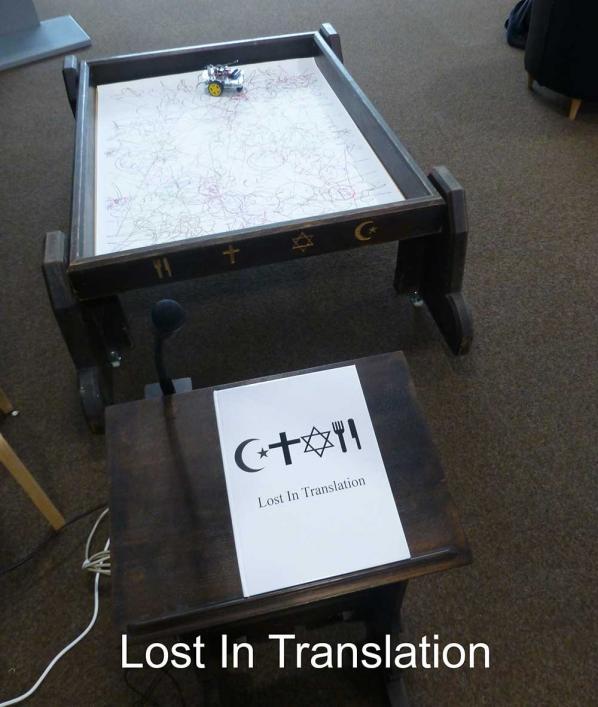
Thank you…
The negotiation of the commons takes place in two distinct realms that are increasingly reaching into and shaping one another: the long history of the landscape commons both in cities and in the countryside, and across digital networks. In both realms we find the continued project of the enclosures, appropriating forms of collectively-created use value and converting it, wherever possible, into exchange value. In this conversation Ruth Catlow and Tim Waterman discuss the ‘Reading the Commons’ project together with Furtherfield’s work on understanding the commons.
Ruth Catlow is an artist and co-founder co-director of Furtherfield. Tim Waterman is a landscape architectural and urban theorist and critic at the University of Greenwich and Research Associate for Landscape and Commons at Furtherfield.
*
TW: I’ll start with a little background. ‘Reading the Commons’ is an ongoing project which we initiated that seeks to find a place of power in order to defend the continual project of the creation of the commons in all realms in the future and to augment and magnify other similar endeavours by other groups and organisations. We knew that there is already a lot of work being done in and around the idea of the commons, so we were less interested in staking out any intellectual ground than we were in making connections and finding ways of sharing research and experiences amongst ourselves and other interested parties. So far two groups have been assembled to read and discuss. The first was convened in the summer of 2014 at Furtherfield Commons, the community lab space in the South West corner of Finsbury Park, and was composed of a broad range of academics and practitioners from different disciplines.[1] It met once a fortnight for several months and discussion was wide-ranging. The second was in the Summer of 2015 and involved a group of Master’s students in curation at Goldsmiths under the direction of Ele Carpenter. Future incarnations of the group will each try for different configurations of people, disciplines, and callings.

RC: The first group was very diverse – from backgrounds in geography, sociology, law, political science, technology, landscape architecture, art, and more. We faced an immediate challenge talking across the boundaries of all these disciplines and philosophical and cultural traditions. This was illustrated immediately in the first session. One of our group, a scholar in Law and Property, was irked by our early introduction of two Americans , Garrett Hardin and Yochai Benkler. We had introduced these theorists along with Elinor Ostrom, Oliver Goldsmith and Michel Bauwens.[2] The law and property scholar was irked for a number of reasons, but particularly because they represented a bias towards a US and UK (English speaking) over other European traditions- of property and ownership over civil liberties. Another participant, with an established practice in arts and technology looked pained throughout. I think this was because we seemed to be scratching the surface of topics, works and discussions that make up the discourse around the network, and the digital commons.
TW: We partially remedied this problem by asking the participants to provide readings for future sections and to give a brief verbal introduction.
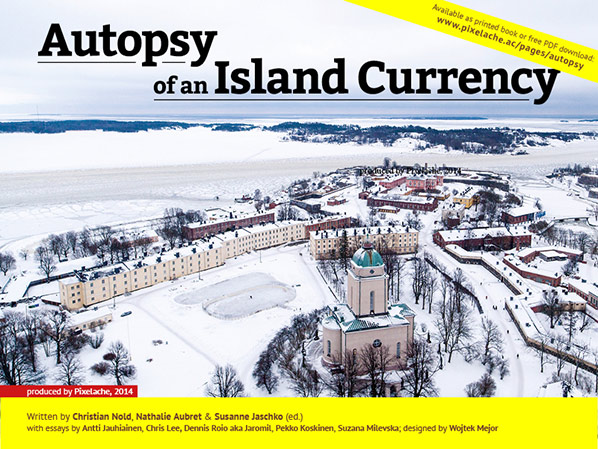
RC: For instance Christian Nold led a show-and-tell at the second session, based on a book, Autopsy of an Island Currency (2014) that he had worked on with Nathalie Aubret and Susanne Jaschko. The book problematises a project called Suomenlinna Money Lab, a participatory art and design project that worked with money and local currencies as a social and artistic medium and that sought to involve a community of people in a critique of its own economies. This reinforced for me the contribution that situated practices have to make to theories of the commons, as the book tells a revealing story of resistance to critique in a place and community with an established interest and investment in the cultures associated with private ownership.
TW: Nevertheless there were a lot of times when people ‘looked pained’, because basically we had just jumped in and started discussing the idea of the commons without realising that we were all speaking with different understandings of basic terms. In other words, we were all operating on different registers that sprang from our hailing from different philosophical and disciplinary roots and traditions. It might have benefited us to begin by trying to map out our terms. On the other hand, this might have prevented us from ever even starting! This mapping, perhaps, is a project that we need to figure out how to undertake.
RC: The difficulty of wrangling different registers was also exacerbated by the seemingly unbounded scope of the discussion. The relatively recent growth of the World Wide Web introduces enough material for months of readings about how the digital commons has helped to shift thinking about the commons away from merely the management of material resources to knowledge and cultural work.
Still, we felt – perhaps because Furtherfield’s physical venues are located within a public park – a sense of urgency to think about the social layers of physical and digital space in relation to the commons, as a way to resist the unquestioning total commercialisation of all realms.
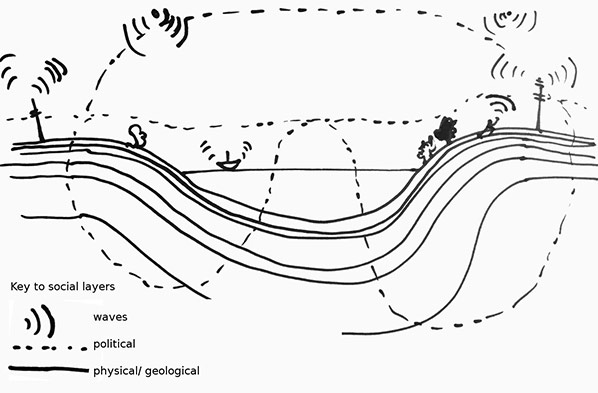
RC: To take a couple of steps back….There are misconceptions about the commons that require rectification. Political economist Elinor Ostrom showed, in opposition to Garrett Hardin, that in theory and in practice, the collective co-operative management of shared socio-ecological resources was a lived reality in many localities (1990). While her research drew on management of material resources her Eight Design Principles for Common Pool Resources, shares many characteristics with digital commons.
Hardin’s (1968) essay “The Tragedy of the Commons” had argued that commonly owned resources were doomed to exploitation and depletion by private individuals; therefore justifying the role of hierarchical, centralised systems of power to maintain private ownership. On the other hand, Jeremy Gilbert in his book Common Ground (2013), quotes radical economist Massimo de Angelis, to define the commons as social spheres which help protect us from the market. This becomes particularly useful to help us to recalibrate our definitions of “free” and “sharing” as we reveal so much of our private lives (so nonchalantly) via ubiquitous, proprietary digital devices and commercial social platforms.
TW: Hardin’s one-dimensional projection of the commons as unworkable and disastrous was based upon an understanding of human relations that assumed that competitive individualism is ‘human nature’ and that all such ‘experiments’ were doomed to failure as a result. This is Darwin’s survival of the fittest rendered as ‘dog eat dog’. The voice almost contemporary with Darwin’s that I think most clearly articulates how evolution (human and otherwise) is based upon cooperation is Peter Kropotkin’s, in his amazing book Mutual Aid (1902). Evolutionary science and theory is moving ever more towards Kropotkin’s conclusions rather than Darwin’s, or at least Kropotkin’s work is becoming ever more relevant and complementary to Darwin’s. For me, it’s also impossible to imagine how cultural evolution could work at all except through the cooperation, sharing, and processes of negotiation that characterise the commons.
The landscape commons has always been about more than just material resources, and this is perhaps the most reductively oversimplified register on which we might speak of the commons. So if the problem is to align the different and more meaningful registers along which we all discuss the commons so that a truly collective and collaborative project can emerge amongst many disciplines simultaneously, we should have a go at pinning in place a few core understandings of the commons? Shall we give that a go?
RC: Yes! From my work with Furtherfield, my feeling for the commons is strongly influenced by the cultures of freedom and openness in engineering and software. In 2011 we created a collection of artworks, texts and resources about freedom and openness in the arts in the age of the Internet. “Freedom to collaborate – to use, modify and redistribute ideas, artworks, experiences, media and tools. Openness to the ideas and contributions of others, and new ways of organising and making decisions together.”[3]
If we can agree that the commons are those resources that are collectively produced and managed by, and in the interests of, the people who use them, then the digital commons, as set out by Felix Stalder, are the technologies, knowledge and digital cultural resources that are communally designed, distributed and owned : wikis, open-source software and licensing, and open cultural works and knowledge repositories.[4] Licences such as the GNU General Public License and various Creative Commons licenses ensure that the freedom to use, adapt and distribute works produced collectively is preserved for the future.
Discussions of the commons have, in the liberal tradition, centred around how to produce, manage and share scarce material resources in a bounded geographical locality. This is fundamentally changed in the post-industrial, information age, where cultural and knowledge goods can be easily, cheaply and quickly copied, shared worldwide and transformed. It has brought about a massive shift in the way economics, politics and law are practiced.
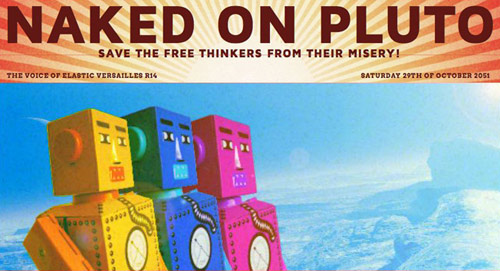
As distinct from the users of the majority of corporately-owned search, sales and social media utilities (think Google, Amazon, Paypal, Facebook, Twitter) and digital entertainment platforms (think Netflix, iMusic and Spotify) the community of people involved in developing the digital commons ‘can intervene in the design and governance of their interaction processes and of their shared resources’ (Stalder) – think Wikipedia, Freesound, Wikihouse. This has long continued to be an area of intense critical inquiry, unfolding, and practice for artists who are creating digital and networked artworks that take the form of platforms, software, tools and interventions such as : Upstage software for online “cyberformance”; Naked on Pluto, an online game whose ‘players’ become unwitting agents in the invasion of their own and others’ privacy ; and PureDyne, the USB-bootable GNU/Linux operating system for creative multimedia.
Consumer cultures invite us constantly to outsource responsibility for knowledge, information and cultural works to the markets. Artists and technologists involved in the digital commons make these otherwise abstract (and often invisible) shifts in power and social relations “feelable” for more people. In this way they are asserting alternatives to the prevailing economic models – often privileging collaboration and free expression that disrupt outmoded models of copyright and intellectual property.[5]
Discussions about the role of affect in the development of the commons will be the subject of the next explorations of Reading the Commons, and we will certainly come back to these.
TW: Let’s look at this from another direction. In landscape terms, the idea of the commons has evolved a great deal over time, as, for example, feudal forms gave way to different hierarchical forms based in capitalism and private property, and now in late capitalism and neoliberalism’s adaptation to, and cooptation of various forms of horizontality, especially in managerial practices. The importance of the commons has also shifted from defining notions of shared ownership and management of agrarian resources to include various manifestations of urban life, most recently and compellingly, perhaps, in the dogmatically horizontal democratic organisation amongst participants in the Occupy movement.

Ultimately, the commons, for me, is about dialogue, sharing, and the relationship between people and place. The earliest expressions of the commons were all about our relationship with food; its procurement, preparation, and consumption. A beautiful historic example is the importance of the chestnut tree to the inhabitants of the Cévennes in southern France, and how it not only embodied the commons, but symbolised it as well. It’s not possible to romanticise this story, as it’s one of very hardscrabble survival, but it does illustrate the point. As a staple food, the chestnut was a matter of survival for the inhabitants of the Cévennes. It would seem, metaphorically, that the idea of rootedness would follow naturally from this as a characteristic of the commons, but the reality is more nuanced. Chestnuts were introduced to the Cévennes by the Romans, and then tended centuries later by monks, who would share plants with the peasants with the expectation of future tithes. Labour-intensive chestnut orchards were farmed not just by locals, but by migrant workers as well. If we fast-forward to the 1960s, chestnuts were rediscovered by those wishing to get ‘back to the land’, reviving agricultural practices that had withered away during the years that capitalism had lured people from the countryside into towns.
This shows a very complex picture of the commons: one in which colonization and imperialism, monasticism, peasantry, migrant labour, and then finally arcadian anti-capitalist mythologies of the 1960s each play a part – and I’m skipping over a lot of historic detail and nuance. There is a tendency nowadays to see the commons as exclusively autonomous and horizontal, but historically the commons have been inextricably bound to patterns of ownership and domination. Far from discounting the commons, this shows how the commons can exist within and exert pressure against prevailing forms of domination and ownership. We need not wait for total revolution or the construction of utopia or arcadia. We can get to work now and make a shining example of what is possible, making use of existing networks and existing places. The anthropologist David Graeber, in his book The Democracy Project, (2014) calls this ‘prefigurative politics’: the idea that by acting out the model of politics and human association and inhabitation that we wish to see, that we work to bring it about.
RC: Yes, and while sociality, rootedness and affinity are all associated with embodied experience, they bubble up again and again in the critical and activist media art community who take digital networks for their tools, inspiration and context. Take for example the Swedish artist/activist group Piratbyrån (The Bureau of Piracy) established in 2003 to promote the free sharing of information, culture and intellectual property. Their entire 2014 exhibition of online and physical installations at Furtherfield Gallery highlighted the centrality to their work of cultural sharing and affinity-building.[6] In his recent conversation with Tatiana Bazzichelli about networked disruption and business, Marc Garrett discusses the importance of affinities in evolving more imaginative, less oppositional (and macho) engagement with regressive forces; and quoting Donna Haraway says “Situated knowledges are about communities, not isolated individuals.”(Haraway 1996).[7]

But Tim, I think you were on a roll. Why don’t you keep going? Why is the commons important now?
TW: The exploitation of people and resources that marks the practices of contemporary capitalism is very much a continuation of the project of the enclosures, whether it is to skim value off creative projects, to asset-strip the public sector which is increasingly encroached upon by the private sector, or to exhaust land and oppress workers in the Third World. The commons, however, are being created continually, and they represent not just a resource to be enclosed and exploited, but a form of resistance that has particular power because it is lived and acted. It’s not at all a contradiction to say that what is common is simultaneously enclosed, exploited, and liberatory. It’s a matter of tipping the balance so that the creation of the commons outpaces its negation.
RC: As people negotiate systems for renewal and stewardship of the resources over time they also arrive at an expression of creative identity and shared values.
TW: A moral economy …
RC: By freely surrendering all collectively created culture, from use value for conversion to exchange value, our shared ecologies of knowledge, culture and land are dismantled.
And with this we stand to lose the ability to attend to the nature of co-evolving, interdependent entities (human and non-human) and conditions, for the healthy evolution and survival of our species.[8]
We are seeing a resurgence of collective and collaborative efforts. Our ongoing DIWO (Do It With Others) campaign[9] sets out to adopt the verve and tactics of DIY culture, but to move us on from its individualism towards imaginative and experimental artistic collaboration. We construct more varied social relations (than those set up by pure market exchange) into the proliferation of connected sensing, communication and knowledge tools, in order to facilitate new forms of trans-global relations and cooperation. Most exciting is the Robin Hood Asset Management Cooperative[10],an activist hedge fund (and the project of economists, critical theorists, artists and financial experts) which distributes shares to members and its profits are invested in pro-social and commons-focused cultural projects.
TW: The point about use value is an important one. Capitalism, in the familiar equation, seeks to convert use value into exchange value. This process abstracts and simplifies value into purely financial terms. The language and action of the commons resists this because it is so often emplaced and embodied. The commons are local, experienced, shared, and negotiated, and they exist within networks of friendship, family, and civil society, which operate as moral economies, not purely monetary ones. I should probably also make the point that the Greek root of the word ‘moral’ signifies custom – which suggests that morals exist in the relational realm of everyday life, rather than in abstract ‘higher’ realms or in abstract financialised realms such as ‘the market’ – and that ‘economy’ comes from Greek again, the oikos, or household. Another firmly embodied and situated idea that is also incontrovertibly relational.
RC: The digital is becoming embodied and situated in a number of ways. Where once the boundaries between the worlds of atoms and bits were marked by screens and passwords, chips and implants are now on or in our bodies, devices and appliances. People and things are becoming increasingly expressive as nodes in the machineweb. Again, this gives artists a vital role in making these effects more legible, feelable and visible. Our actions are tracked, our utterances and exchanges are monitored, and our behaviours inform the design of future media, systems and products. This is the cybernetic loop.[11] We also see a growing awareness of the geo-political questions surrounding the physical infrastructure of the Internet and its role in global markets. The problematisation of the web through heated debates about ownership and control of infrastructure and data, privacy and surveillance expressed in the SOPA debates- the Edward Snowden affair; Tim Berners-Lee’s campaign for a Magna Carta for the web; calls for a Digital Bill of Rights; the development of decentralising blockchain technologies that underpin Bitcoin, Etherium and (many other projects; artistic projects with a Situationist verve such as those of Piratbyran and F.A.T Lab- these all help us to clarify our place, the opportunities and limits for agency and action as we straddle the physical and digital layers.
So then we come back to the question of resistance and the commons. If, as you’ve described above, the continued project of the enclosures sets the scene for new acts of resistance, how Tim do you see these acts taking place in landscape space?
TW: The fact that democracy and the commons both take place (literally a historic act is situated by its taking place) by occupying space as well as by initiating dialogues and negotiations is important. Occupying digital space is important, as you have shown Ruth, and resisting the forms of surveillance and control that seek to close down the digital commons. I take hope from the fact that even if it takes generations to end capitalism, or at least to shift it from a form of global governance to a competitive economic system more appropriate to the scale of the farmers’ market, that the commons will never be fully enclosed, because capitalism is dependent upon the commons to create value that it then marketises and financialises.
Defending the digital commons also occupies physical space. It will be, from time to time, necessary to occupy the streets and squares of our cities in protest to stand up for them. In doing so we stand up for the physical commons at the same time. Governments have all sorts of tools against public demonstrations, such as the British government’s recently renewed hostility to trade unionism and its desire to further limit strike powers. Strikes will happen whether they’re legal or not though, as history amply demonstrates. Often many instances of land occupations are seen to have failed, however they have to have succeeded, at least temporarily, to register in the historical record as symbolic moments. These moments have immense power. The Diggers, for example, followers of Gerrard Winstanley, were proto-anarchists who organised horizontally in their land occupation in Surrey, Northamptonshire, and Buckinghamshire in the mid-1600s. Their planting of vegetables on common land, though a brief experiment, lives on powerfully in the discourses of democracy.
More modern incarnations of this power include the access to land gained by the mass trespass at Kinder Scout, the long-term encampment at Greenham Common, and the incredibly powerful and highly visible symbolism of the Occupy movement in various places from New York to London to Istanbul and beyond. A recent echo of the Diggers is the occupation of Grow Heathrow, which seeks to prevent the airport’s expansion by peacefully living on land proposed for a third runway and growing food there.
RC: So our next steps both for Reading the Commons and in our acting out of the commons are to define and map, for the purposes of resistance in the ongoing creation of commons; digital collaborocracy and an exploration of affect, agency, embodiment and the commons. Creative practices under capitalism have long contained elements of both creation and resistance (or defence), and now these actions, both positive and negative, take place across the digital and situated realms as well as what might now be termed the ‘situated digital’.
TW: I’m pursuing ideas of what Kate Soper calls ‘alternative hedonism’ so that sustainability can be conceived of as joyful. I think satisfaction – the fulfillment of desire – can have radical transformative potential for prosperity as a collective pursuit and is perhaps the only way to tip the balance away from liberal and neoliberal individualist competitive models. My idea of the commons and commoning includes freedom, democracy, nice cups of tea, evenings spent drinking wine and talking, the elimination of poverty, and the flourishing of human habitat and human potential.
RC: Let’s all drink to that!
Many thanks to Professor Jeremy Strong and Dr Penny Travlou for their feedback and notes on this text!
Axelrod, Robert (1984), The Evolution of Cooperation, Basic Books, 2006
Barnes, Peter. (2001) Who Owns The Sky? Our Common Assets and the Future of Capitalism, Island Press
Bauwens, Michel. (2013) Class and Capital in Peer Production.
Bauwens, Michel. (2005)The political economy of peer production. http://www.informatik.uni-leipzig.de/~graebe/Texte/Bauwens-06.pdf
Benkler, Yochai. (2011) The Penguin and the Leviathan: How Cooperation Triumphs Over Self-Interest.
Boal, Iain. The Long Theft: Episodes in the History of Enclosure (forthcoming)
Bollier, David. Think Like a Commoner: A Short Introduction to the Life of the Commons and/or Viral Spiral. How the Commoners Built a Digital Republic of Their Own. New York, London, New Press, 2008 http://www.learcenter.org/pdf/ViralSpiral.pdf
Caffentzis, George. (1973) “Introduction to the New Enclosures” in Midnight Oil: Work, Energy, War.
Clare, John. (1827) From ‘April’, The Shepherd’s Calendar http://www.johnclare.info
DEFRA. (2003) Countryside and Rights of Way Fact Sheets http://adlib.everysite.co.uk/adlib/defra/content.aspx?doc=63428&id=63430
De Angelis, Massimo. (2003) ‘Reflections on alternatives, commons and communities’ http://www.commoner.org.uk/deangelis06.pdf
De Angelis, Massimo and Stavrides, Stavros. (2010) ‘On the Commons: A Public Interview with Massimo De Angelis and Stavros Stavrides’ http://www.e-flux.com/journal/on-the-commons-a-public-interview-with-massimo-de-angelis-and-stavros-stavrides/
Dragona, Daphne. (2013) ‘Artists as commoners in the years of indebtedness’ http://ludicpyjamas.net/wp/?page_id=815
Federici, Silvia. (2004) Caliban and the Witch: Women, the Body, and Primitive Accumulation (Book) http://libcom.org/files/Caliban%20and%20the%20Witch.pdf
Gilbert, Jeremy. (2013) Common Ground – Democracy and Collectivity in an Age of Individualism
Goldsmith, Oliver. (1770) ‘The Deserted Village’ http://www.poetryfoundation.org/poem/173557
Graeber, David. (2013) ‘A Practical Utopian’s Guide to the Coming Collapse’ http://thebaffler.com/salvos/a-practical-utopians-guide-to-the-coming-collapse
Haraway, Donna. (1983) ‘The Ironic Dreams of a Common Language for Women in the Integrated Circuit’ http://www.egs.edu/faculty/donna-haraway/articles/donna-haraway-the-ironic-dream-of-a-common-language-for-women-in-the-integrated-circuit/
Hardin, Garrett. (1968) The Tragedy of the Commons http://www2.geog.ucl.ac.uk/~mdisney/teaching/tutorials/hardin_1968.pdf
Harvey, David. Rebel Cities (2013) http://mappingthecommons.wordpress.com/2012/11/13/the-creation-of-the-ur…
Hyde, Lewis. Common As Air: Revolution, Art, and Ownership. 2010
Kropotkin, Peter. Mutual Aid and/or Fields, Factories and Workshops Tomorrow. 1898 http://www.complementarycurrency.org/ccLibrary/Mutual_Aid-A_Factor_of_Evolution-Peter_Kropotkin.pdf
Lessig, Lawrence. Code and Other Laws of Cyberspace.1999 http://codev2.cc/download+remix/Lessig-Codev2.pdf
Lessig, Lawrence. (2004) Free Culture http://www.free-culture.cc/freeculture.pdf
Linebaugh, Peter. The Magna Carta Manifesto: Liberties and Commons for All. Berkeley: University of California Press, 2008 http://provisionaluniversity.files.wordpress.com/2012/12/peter-linebaugh-the-magna-carta-manifesto-liberties-and-commons-for-all-2008.pdf
Linn, Karl. “Reclaiming the Sacred Commons” and/or Building Commons and Community. Oakland: New Village Press, 2007 http://nccommunitygarden.ncsu.edu/Karl-Linn-ReclaimingTheSacredCommons.pdf
Marx, Karl. (1844) Private Property and Communism. http://www.marxists.org/archive/marx/works/1844/manuscripts/comm.htm
Massey, Doreen. (1994) A Global Sense of Place http://www.unc.edu/courses/2006spring/geog/021/001/massey.pdf
Merchant, Carolyn. (2006) The Scientific Revolution and the Death of Nature http://nature.berkeley.edu/departments/espm/env-hist/articles/84.pdf
Morris, William. News From Nowhere 1893. http://www.sfu.ca/~poitras/Morris_News-from=Nowhere.pdf
Mumford, Lewis. (1964) Authoritarian and Democratic Technics http://www.nyu.edu/projects/nissenbaum/papers/authoritarian.pdf
Nold, Christian and van Kranenburg, Rob. (2011) The Internet of People for a Post-Oil World. http://www.situatedtechnologies.net/?q=node/108
Olwig, Kenneth. (2002) Landscape, Nature, and the Body Politic. University of Wisconsin Press. http://avblivinglandscape.files.wordpress.com/2011/01/olwig_1996.pdf http://dlc.dlib.indiana.edu/dlc/bitstream/handle/10535/77/commons_and_landscape.pdf?sequence=1
Ostrom, Elinor. (2010) “Beyond Markets and States: Polycentric Governance of Complex Economic Systems,” American Economic Review, 100(3), pp. 641-72.
Ostrom, Elinor and Hess, Charlotte, Eds. Understanding Knowledge as a Commons: From Theory to Practice. The MIT Press, Cambridge, Massachusetts, 2006.
Ostrom, Elinor. Governing the Commons. 1990 http://wtf.tw/ref/ostrom_1990.pdf
Ostrom, Elinor, and Gardner, Roy, and Walker, James, Eds. Rules, Games, and Common Pool Resources. Ann Arbor, University of Michigan Press, 1994
Platt, John. Platt, J. (1973). “Social Traps”. American Psychologist 28 (8): 641–651. doi:10.1037/h0035723.
Rexroth, Kenneth. (1974) “Communalism: From Its Origins to the Twentieth Century” http://www.bopsecrets.org/rexroth/communalism2.htm
Sennett, Richard. (2012) Together: The Rituals, Pleasures & Politics of Cooperation.
Ward, Colin. (2012) Talking Green or ‘Play as an Anarchist Parable’ from Anarchy in Action. http://libcom.org/files/Ward_-_Anarchy_in_Action_3.pdf
Winstanley, Gerrard (1649). A Declaration from the Poor Oppressed People of England http://www.bilderberg.org/land/poor.htm
Copyright has been a relevant topic since the development of the printing press. It grants the author the exclusive right to reproduce, publish, and sell the content and form of intellectual property. The copy & paste mentality of the Internet user brought chaos to the system. Blockchain technology should now manage the author and marketing rights in a way that is more transparent, completely free of Bitcoin and monetary background. The idea had its origin in the art scene.
The Internet is a space without horizons or frontiers. It has changed our environment and also, thereby, our sensory perception. In ‘the real world’ we are confronted everywhere by people gazing deeply into smartphones: on the street, on the subway, in airplanes, in queues and cafés. Interpersonal dialogue is increasingly being conducted in the virtual sphere. How does the art scene react to new technological developments in arts? I asked Alain Servais (collector), Wolf Lieser (gallerist) and Aram Bartholl (artist.)
AD: Alain, you are collector of digital art since many years. How actively do you use the Internet and the possibilities that it brings for research into art?
AS: I have the opportunity to generally be able to experience art in the real. This is still an indispensable element in the process of acquiring. I’m a big user of the Internet when it’s a question of looking for information on art that’s of interest to me. The key information I always try to gather before acquiring a work is: – a document collating the works which have marked the evolution of the artist’s practice –a piece of writing by an academic, curator or critic contextualizing the artist’s work – an interview with the artist, as I want to hear his/her ‘ voice’ speaking about on his/her art – and a biography.
AD: Wolf, how much do you use the Internet and its possibilities for better marketing in the art scene?WL: We have a presence on various social media and websites, for example, FB, FLICKR, Bpigs, ArtfactsNet, etc. But we try to limit it to those pages that are relevant to art. As an actual communication medium we primarily use Facebook.
AD: Aram, killyourphone.com provides relief and a critique of technology. What would your subjects be without the Internet?
AB: Despite rising levels of communication across devices and networks, I nonetheless notice how, when friends express their opinions on the social media channels, they do so ever more consciously and selectively. We’ve come to understand that all of the commentary and spontaneous utterances on Twitter, FB & co no longer just disappear, but are saved, analyzed and used. ‘Private is the new public’, said Geraldine Juarez recently. The belief that the net makes the world fantastically democratic and offers an equal chance for everyone has, at least since Snowden’s revelations, been finally buried. To that extent, the theme ‘how would it be without the Internet?’ is very interesting! How could we communicate without central, monitoring services? Which low-tech DIY technologies are available in order to exchange data ‘offline’? How can we live without Google?… (A self-test is strongly recommended).
The interplay between the old and new environments leads to numerous uncertainties and generational conflicts. While some nostalgic digital immigrants still assess the advantages of the digital world as being synthetic, alien and unsocial, to the generation of digital natives, the digital abundance is felt as entirely natural. For them, the new technologies were with them in the cradle.
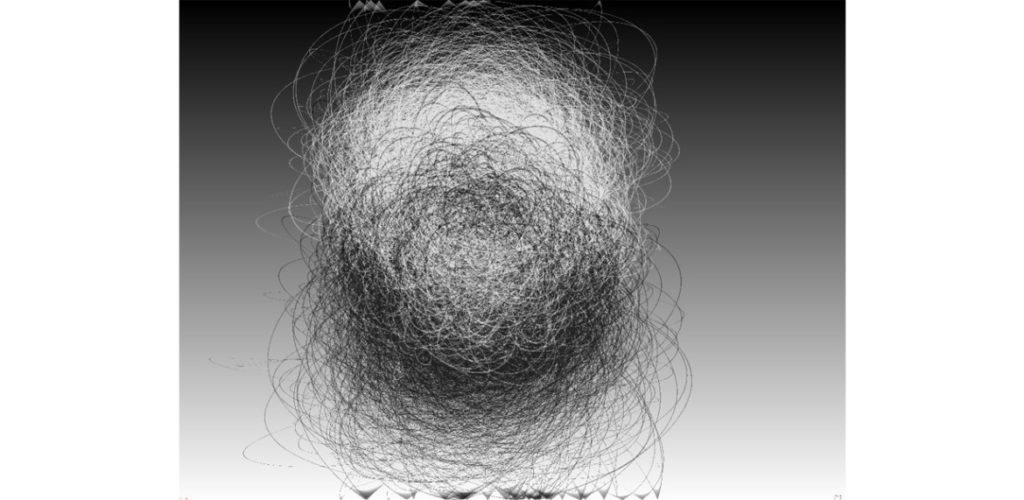
AD: Alain, you are a digital immigrant. What was the first media work in your collection? When did you buy it and why?
AL: My first experience with digital art was with bitforms gallery in NY, more than 10 years ago – at a time when it was really under the radar. I went to an exhibition by Mark Napier from whom I acquired a work at that time – one of the “Old Testament” pieces. That was very natural for me, because I was looking for some new kind of art. I knew enough of art history to know that every important movement in art was always linked to a social, economical, technological, psychological development in society. It was a time, when I was trying to collect works that were really addicted/connected to the actual world, the world around us. I was thinking, ok let’s put myself in 2150: when I’ll be using my third heart and my second brain, what will I say was important in the year 1999/ 2000? Without any doubt it will be the computer and the Internet 2.0 with Facebook and social networks and everything. Eventually I thought: wow people were creating art and it is digital. I immediately considered it to be a very important development for the arts.
AD: Wolf, you procure and sell digital art. What do you think today is the greatest obstacle to understanding the effect of new media?
WL: The sale and procurement via the Internet leads to superficiality. This is, at least, my perception. Experiencing art on a website, interactively or not, is often characterized by shorter cycles/loops compared to viewing the same website here in the gallery. I think we need, as we always did, a balance between the real and the virtual. And actually, this makes sense, because we ourselves do embody both. It’s a reason why the digital natives often express themselves in analog media – it’s no coincidence!
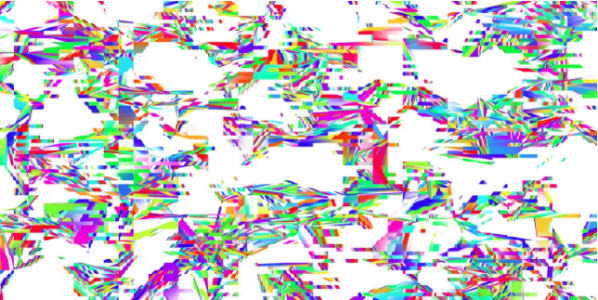
AD: Aram, your works stand at the charged interface between public and private, online and offline, between technological infatuation and everyday life, whereby you teach us how to better understand our new environment. ‘ Whoever sharpens our perception tends to [be] antisocial …’, said media theorist Marshall McLuhan. Is it true?
AB: Especially TODAY it is more important than ever to sharpen perception with regard to the effects of technological development. Two and a half years after Snowden the public discussion on privacy and mass surveillance continues to level off. While the big secret services use their hefty budgets to snow us under, and to lock the doors to the NSA, the interest in further explosive leaks from the Snowden documents is fading. ‘Nothing to hide’ is the mantra of the ‘Smart New World’, in which we can neither see nor sense the complex mechanisms of surveillance. In contrast to the dystopic Matrix scenario, our world will ever be fluffier, smarter and more comfortable, unless one has the wrong passport or sits on a bus next to a presumed terrorist. Then reality will be brutal. Precisely for these reasons it is so important to make the hidden, abstract data world understandable, whether through concrete images, objects, or installations. If you were to hold 8 volumes with 4.7 million passwords of LinkedIn users in your hand hand, you would suddenly understand the significance of the security of our online identities.
Copyright has been a relevant topic since the development of the printing press. It grants the author the exclusive right to reproduce, publish, and sell the content and form of intellectual property. The copy & paste mentality of the Internet user brought chaos to the system. The blockchain technology should now manage the author and marketing rights in a way that is more transparent, completely free of Bitcoin and monetary background. The idea had its origin in the art scene.
AD: Alain, do you think the further development of the blockchain lead to more transparency and protection against forgery?
AS: I would not use the word forgery, but certainly [against] an unfair use of material or a copyright infringement. I suppose that the blockchain is one path that should be investigated and tested for the copyright protection of online works of art. I believe in a transformation of the economy of the market for online art towards the direction of a wider distribution through, perhaps, a ‘renting’ of the work rather than an illusory acquisition (taking into account the copyright stays with the artist anyway). i-tunes and Spotify both adapted well to the online art economy.
AD: Wolf, do you make use of these new possibilities within the marketing of digital art? And have you already thought about a new currency model?
WL: I’ve already been confronted by this and I think that it makes sense. With my artists though there’s as yet no need or willingness. I’ve yet to engage with new currency models.
AD: Aram, to what extent is the blockchain and Bitcoin really discussed within artist circles?
AB: Services like Wikipedia, the Open-Source Software movement and, in principle, the entire World Wide Web wouldn’t exist at all today had Telco-payment-services pushed through its fee-based BTX/videotext with pay-per-view, in the 1980s. Naturally the possibility turns the never-ending reproduction of classic markets on its head, and in recent years, there have been extensive debates about copyright and intellectual property. We shouldn’t forget though, that a large part of the software that operates the Internet and millions of devices came about in the spirit of the sharing-culture. The blockchain is a powerful tool, which introduces a form of artificial scarcity into the digital environment. It’s up to each artist himself or herself whether and how he or she chooses to distribute their work. The art market and the demand will certainly create some model or other for the sale and distribution of art that only exists in bits and bytes. Let’s wait and see…
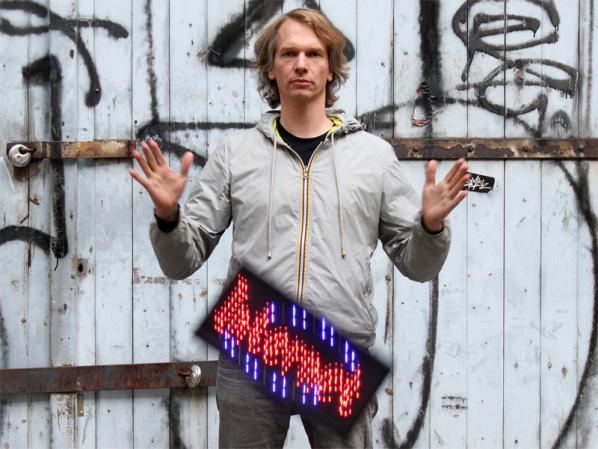
Angela Washko is an artist, writer and facilitator devoted to creating new forums of discussions in spaces most hostile towards feminism. She is a Visiting Assistant Professor at Carnegie Mellon University. Since 2012, Washko has also been facilitating The Council on Gender Sensitivity and Behavioral Awareness in World of Warcraft, her most known project: it’s a series of actions taken within the virtual space of World of Warcraft (“WoW”), an online video game set in a fantasy universe in which people play as orcs, knights and wizards. Her research is focused on the social relations between the gamers, with great attention towards on how these relate with feminism and women, who are becoming more and more numerous between the players of this game. Washko investigates also how design elements of the game influence the relationships of the people who inhabit it; it’s a social study on a community expanding more and more widely, and acts within a limited set of rules designed by video game producers.
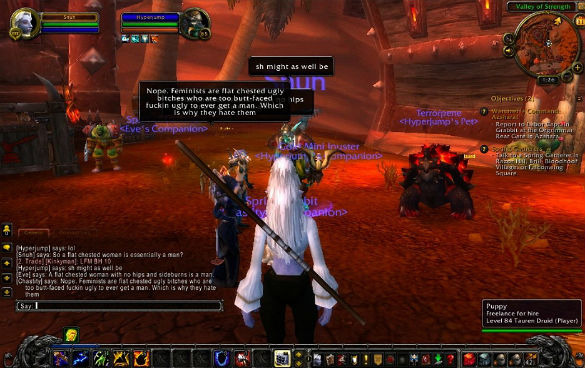
Filippo Lorenzin: I’ve read in some your previous interviews that you started playing WoW in 2006, so we can say you’re a veteran gamer. In the same interviews you pointed out many important elements linking to some of my own research. First of all, the fact you didn’t hesitate to make a parallel between IRL public spaces and online public spaces makes me think you’re part of a generation (as me) that doesn’t care of this division. You create situations and opportunities to let people discuss: it’s as if you meant online gaming as a social activity, rather than a set of rules designed by programmers in which people interact as NPCs (“Non-Player Characters”). What do you think?
Angela Washko: I wouldn’t say that I don’t make a distinction between online and offline space… rather, that these spaces are so integrated and much less separate than the outdated “it’s online/digital therefore it’s not real” model. Online gaming is a very general term and they each have a specific way of operating with contexts that have particular ways of allowing players to communicate to each other. Some of those games are designed to institute high degrees of collaboration in order to get to the most difficult content. World of Warcraft falls into this category. This coercive collaboration breeds a social/chat structure which makes the game as much of a social space as a play space.
My work in WoW is about analyzing the user’s social culture created within the otherwise fantasy oriented landscape and talking to players about the way that it’s developed. So of course there are thousands of things I could have focused on within WoW (and in The World of Warcraft Psychogeographical Association I focus more on exploring the landscape free from quest suggestion/utility and drift about exploring), but for The Council on Gender Sensitivity and Behavioral Awareness in World of Warcraft I was driven to work the way I did due to the treatment of women by the community within the space once players establish their self-identified gender behind the screen. At least on the servers I was playing on.
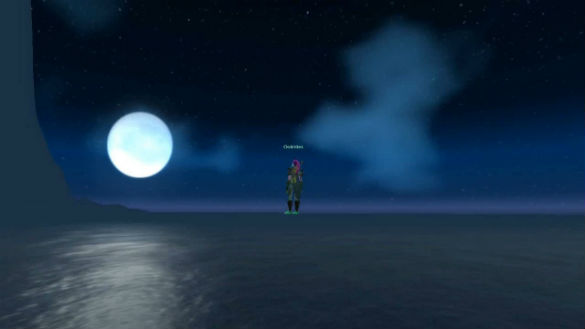
FL: Your use of WoW mechanics in order to raise questions about sexuality and identity makes me think of situationist approaches. As they wanted to create new urbanism refecting the grounded needs and identities of the people, and your actions seem to lead to the creation of a new gaming system, based on players/people who aware of the characteristics of the game and their results in the definition of their identities. Am I wrong?
AW: I guess in WoW I was wondering why the politics of everyday life outside the screen had to govern the rules of this otherwise epic and otherwise not-human-like landscape. I wondered why women were excluded or treated as though they were inherently unskilled (naturally/biologically non-gamers) and at the same time were rewarded for being willing to be abstractly sexualized in guild hierarchies and elsewhere. After being asked to “get back in the kitchen and make [insert player name here] a sandwich” enough times, I stopped playing for a bit. And then I returned, determined to figure out why this was an ubiquitous approach to talking to women in the game space. So I wanted it to be in a place where we could openly discuss and potentially become more considerate about communal language to the point that it could become a much more inclusive space for everyone, and maybe a more diverse social space than we all curate for ourselves in our everyday (physical space) life. Why did our identities outside the screen still have to govern how we are treated as orcs and trolls and whatnot? This game still holds onto a lot of the qualities of the avatar-hidden web 1.0 persona…
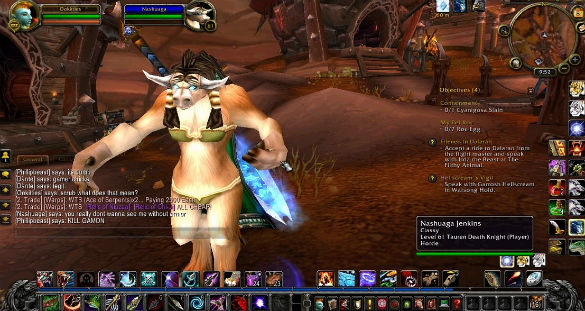
FL: Debord wrote that “the construction of situations begins on the other side of the modern collapse of the idea of the theatre. It is easy to see to what extent the very principle of the theatre – non-intervention – is attached to the alienation of the old world. Inversely, we see how the most valid of revolutionary cultural explorations have sought to break the spectator’s psychological identification with the hero, so as to incite this spectator into activity by provoking his capacities to revolutionize his own life. The situation is thus made to be lived by its constructors.”.
As you can see, it looks like he’s describing your work and I’m really curious to know your opinion.
AW: Well, I have thought about this work (and the psychogeographical work that came slightly later) as definitely linked to Debord and Situationism. I think I became tired of just being able to show the injustices women face everyday. Just prior to the WoW work, I was making videos from replaying single player RPGs from 1992-2003ish showing only women’s storylines and the ways women were represented. I think the work shocked the gallery audiences who saw it because they weren’t gamers and instead of making them think about why the ways in which “women are supposed to act” are embedded in all of our cultural artifacts – it made audiences ask me why anyone would play video games? This frustrated me because I hated the 90s stereotypes that existed about gamers being delinquent and lazy and so I wanted to have conversations in game spaces themselves among the communities that I was involved in rather than just taking from games and then putting them into an art context to be exoticized by art audiences. This is changing a lot as more people identify as gamers and more academics realize the massive amount of people that play games and the cultural importance of games themselves. But I wanted to be able to create a space for discussion with the playerbase itself directly and make that the work rather than making some kind of insightful commentary – to give voice to the community itself to let it speak for itself (regardless of my point of view on the matters discussed) and at the same time try to make sense of how it ended up the way that it did.
FL: The players are being involved in discussions about sexuality and identity. Could you tell your art and cultural references? I can see a lot of ’60s and ’70s approaches…
AW: Oh yes – I mean artists like Valie Export, Adrian Piper, Lynn Hershman, Sophie Calle and the Guerrilla Girls of course, in terms of performance and visibility of women and feminism/feminist activism but in terms of public/media intervention and social practice I think of people like Paper Tiger TV, The Yes Men, The Center for Post Natural History, The Institute for Applied Autonomy, Dara Greenwald, Ant Farm, Kristoffer Orum and Anders Bojen.
I also feel very indebted to remix/appropriation artists like Craig Baldwin who have reclaimed what can be used and how we can rethink existing pop cultural material as sites of intervention for artwork. I also feel like I’m even more influenced by diaristic women writers– particularly Phoebe Gloeckner, Kathleen Blee (sociologist), Elfriede Jelinek, Chris Kraus, Kathy Acker…
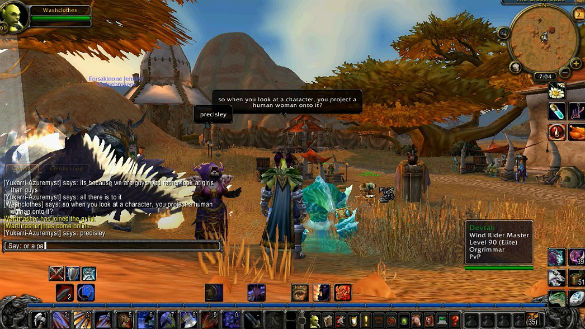
FL: Though question: do you think artists have (or “must have”) a social role? And if they take a stand, what should be their goals?
AW: I think for me interesting artists have a social role! I don’t think that all artists have to make socially engaged work or have to have some kind of service responsibility. I think what was appealing to me about pursuing art as a context for the things I aspire to do is that it is so broad! I mean you have so many “art worlds”, this is a really broad question! So I would say no, but I think artists are in a unique position to have so much flexibility in what you’re permitted to do in your work. In a sociology context, my work would require so much paperwork it would be impossible to get every player I talk to in WoW for my research to sign the necessary papers outside of the game space! So art affords me the flexibility, spontaneity and responsiveness to context to experiment, and really get in there in a way that other fields don’t. So I have found for someone interested in looking at why women are treated the way that they are in fields that are ephemeral and difficult to document, and wanting to have direct discussions about it…art seems to be the field for me to do it in.
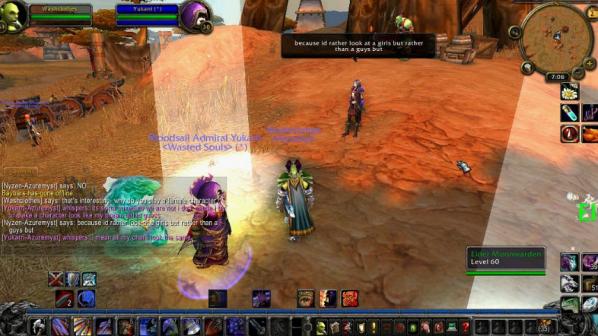
FL: What did you learn from your projects?
AW: Things that I learned which I think will be beneficial for me in the future:
– Be responsible and respectful to everyone you work with.
– Be flexible and responsive. Recalibrate your expectations and be prepared to be wrong about every assumption you’ve already made.
– Think about power. Remember that by being able to capitalize on what you collect, you are in a position of power – make efforts to put yourself in positions of vulnerability. Acknowledge whether or not what you are doing is exploitative. Make everything you do available to all participants who are interested.
– Be clear about what you are doing with the people involved. Be upfront with your participants.
FL: As you previously stated, feminism is a really important element of your research. Did you notice any change between 2010 and now? I’m especially referring to how feminists are portrayed by society, the opportunities in which you can debate and share ideas with somekind of new wave of young artists and critical thinkers who are also deeply involved in these discussions.
AW: When I first started the project, “feminism” was the worst possible word you could say in WoW. Everyone went crazy – feminists were widely described as man-hating whores, flat-chested ugly bitches, women with hairy armpits and worse. But I’ve definitely noticed over time with more mainstream visibility and more writing and a younger generation of artists and celebrities identifying proudly as feminists…the discussions about feminism have become much more complex in WoW and there are many more perspectives and a lot more people self-identifying that way in the space.
Outside of WoW, it seems like more and more women are identifying as feminists and a lot of young writers are really making space for feminism in mainstream media. However, I think it’s been quite polarizing and alienating as well. More and more Men’s Rights Activist groups and nearly militarized manosphere communities are popping up. So with the growth of feminism we also have the growth and visibility of self-identified counter-feminist movements. I think the fact that feminism is a part of mainstream media vocabulary in a way that is a bit more dimensional is definitely positive. The ideas of what a feminist and what a woman can be/do are shifting and evolving and that’s exciting to see.
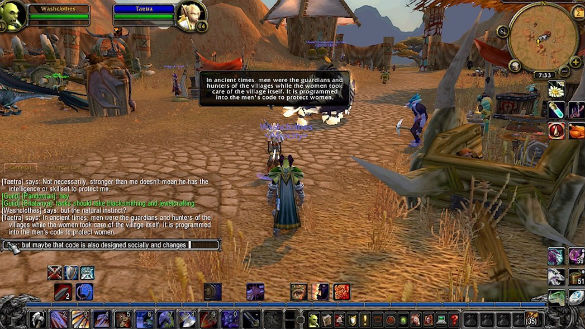
FL: Products like WoW are designed for a masculine audience but looks like it’s not so evident for most of them. With your actions you push other players to discover this aspect, so I wonder if you would define your research as critical art, and or an art that helps others to see the reality behind what the system teaches them).
AW: I would definitely call my work critical art in regard to what you’re proposing! I think in all of my work I am looking at systems and trying to reveal the way they work, using an approach that is accessible to wider audiences than the systems typically reach. I like to approach cultural artifacts by exploring and then dissecting them and then translating/excavating those findings from the site and sharing them as widely as I can.
Choose Your Muse is a new series of interviews where Marc Garrett asks emerging and established artists, curators, techies, hacktivists, activists and theorists; practising across the fields of art, technology and social change, how and what has inspired them, personally, artistically and culturally.
Since 1989, Igor Štromajer aka Intima has shown his media art work at more than a 130 exhibitions, festivals and biennials in 60 countries. His work has been exhibited and presented at the transmediale, ISEA, EMAF, SIGGRAPH, Ars Electronica Futurelab, V2_, IMPAKT, CYNETART, Manifesta, FILE, Stuttgarter Filmwinter, Hamburg Kunsthalle, ARCO, Microwave, Banff Centre, Les Rencontres Internationales and in numerous other galleries and museums worldwide. His works are included in the permanent collections of the Centre Pompidou in Paris, the MNCA Reina Sofía in Madrid, Moderna galerija in Ljubljana, Computer Fine Arts in New York, and UGM.
Available as:
– PDF file 0sn-3iexfemiat.pdf (2.7 MB, 206 A4 pages)
– EPUB file 0sn-3iexfemiat.epub (884 kB); Open eBook Publication Structure (Kobo etc)
– mobi file 0sn-3iexfemiat_mobi.zip (994 kB); Kindle (3 files: mobi, apnx, mbp)
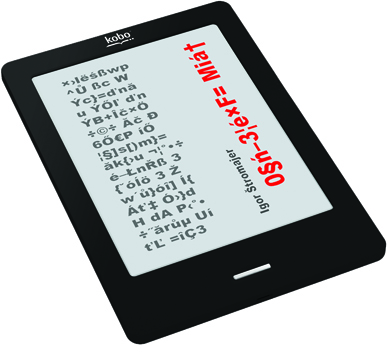
Marc Garrett: Could you tell us who has inspired you the most in your work and why?
Igor Štromajer:Ajda Likar, Aleksandra Domanović, Alexei Shulgin, Ana Isaković, Andy Warhol, Angela Washko, Anne Magle, Anne Roquigny, Annie Abrahams, Annika Scharm, Antonin Artaud, Aphra Tesla, Bertolt Brecht, Bojana Kunst, Brane Zorman, Brigitte Lahaie, Carolee Schneemann, Chantal Michel, Charlotte Steibenhoff, Curt Cloninger, Diamanda Galás, Dirk Paesmans, Dragan Živadinov, Falk Grieffenhagen, Florian Schneider, Fritz Hilpert, Gabriel Delgado-López, Georges Bataille, Gertrude Stein, Gianna Michaels, Gina Spalmare, Gretta Louw, Henning Schmitz, Ida Hiršenfelder, Immanuel Kant, Italo Calvino, Ivan Jani Novak, James Joyce, Jerzy Grotowski, Jim Punk, Joan Heemskerk, Johann Sebastian Bach, John Cage, John Lennon, Jorg Immendorff, Josephine Bosma, Judith Malina, Julian Beck, Karl Marx, Karlheinz Stockhausen, Kazimir Malevich, Lars von Trier, Laurie Anderson, Laurie Bellanca, Lucille Calmel, Ludwig Wittgenstein, Luka Prinčič, Marcel Duchamp, Margarida Carvalho, Maria Winterhalter, Marie-Sophie Morel, Marina Tsvetaeva, Marisa Olson, Marjana Harcet, Marko Peljhan, Martine Neddam, Matjaž Berger, Minu Kjuder, Morena Fortuna, Nam June Paik, Nana Milčinski, Netochka Nezvanova, Nika Ločniškar, Olia Lialina, Peter Luining, Philip Glass, Ralf Hütter, Robert Görl, Robert Sakrowski, Robert Wilson, Robin Dunbar, Ronnie Sluik, Sergei Eisenstein, Simone de Beauvoir, Srečko Kosovel, Stanisław Ignacy Witkiewicz, Stanley Kubrick, Suvi Solkio, Thor Magnusson, Ulrike Susanne Ottensen, Varvara Stepanova, Vesna Jevnikar, Vladimir Mayakovsky, Vlado Gotvan Repnik,Vsevolod Meyerhold, Vuk Ćosić, Yevgeny Vakhtangov.
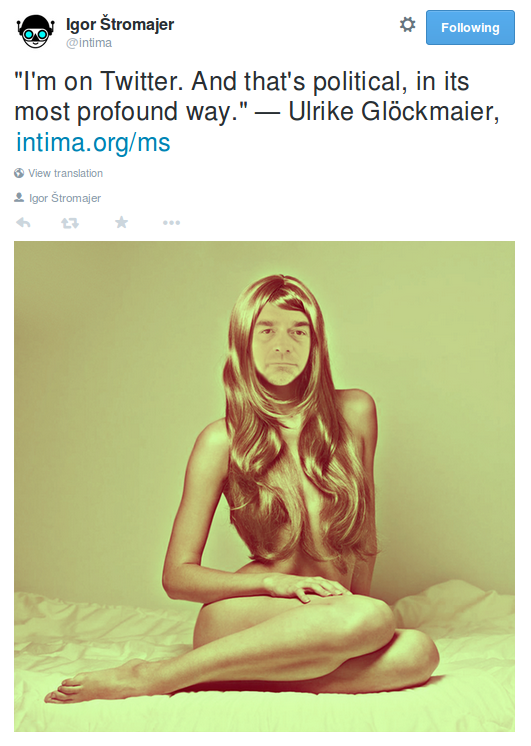
MG: How have they influenced your own practice?
IŠ: ×›lëśßwp^Ů ßc W Ýc}=ďnău ÝŐľ ďnÝB+Îč×Ö÷©÷ Ăč Đ6Ő€P íŐ¦§]s[)m}=ăk{›u ¬¦ °•÷ é–ŁnŘ ß 3 {ˇóĺö 3 Žw´ů}óî] Í{Áť‡ Ó›}dH dA P‹° •÷˝ărůµ U흼 =îÇÉč 駝s™Ý ´Ë5˘şĄ Ű•Ż ěďu pŔ ‚Řw] bűÝ« ď}7» ú9f×Sî “•!«+q ą^őI[}vÝr«ĺn÷ Ľ ÓŰŰ Ż7Ş5g4Ť 0őÝc%ž ›Ź{ zM” ¬¦ °•÷ žl” v:i* p 4®Ú Ws›VęÖ’Fť«M˝ď{Ó¸sëÁäzç} zŻsS§NůŚńŞ%z=t{Ĺź4$ ˇ@ čТ€H) P]e †´B Ćťë®I ďwNë »DîŮ Î2P € Ă@ˇˇ ’Š ¨ iˇ+[ŔĆ 0 ŽŞ…_©2ô†YCHâAĐ ůđ ‰R!h ¨––‚)”˘!i ĆÓI KXµ …\d äPŔ t©’¤6‘ Kď ń˛ ‚ I \l ”Q,Ať „ň [ Because I have nothing to say and I’m saying it. The highest purpose is to have no purpose at all. ] ÉBÜÍ%TD IQNŔ – ¦”bbJv•M € Ä ˛-•H6•J Đspś“ Đť°Ł Ä gl @a Ä Ä cÍ‹˛ˇJ ! cĚäŠGČÄTDM L@PĐÄ ! D&Ĺ9Ť d¦¨§ó„ĚÓQ 튚 ÉC Ô$M Ö=ě ŢĘS÷…O‚ üś ^cFoŃŚ îpPÄ I@Rb bĂHhX™b 4¤i$”dwŰ ž$ .‰˘ ăóy LJSAT QI 7Ž –j(” :Ę‚jż oděG ę®h Ňáo Ăłg K÷ţk D% 9(ö¤řÜ Ľ9B Jí6ő¸n Tvôiő}@8„EO ¬¦ °•÷ bŻý!Ćńě BlÁé [řŤeÚ ‡ »Â ő˙2ľ p6Ř?¨6 Óű;7 ú3 Ś«˛ ŕ8ó ĘŐ@Ř‚˘ĹŞNÎ ž$n:vAňá Ý f ąŮ0 WżÝđ” Ł •ŻŮ vőtĽ Ďg«út’´ž W¦Ś] 0§ń–3¦é×F= ]iᆠ• „ü ¬¦ °•÷ ˙®k ŢyÚŢâ ţ ĂóJUţŮ ä …˛” 9Ů ţ˝Ó{ Ě›9ôĚŕ Š¸·fˇµÁP¸ş Dşź ´ľtÜŢ ŻŇĽ· 瀝,& ëÄŔ´DőJň% &–<VĐlŃ fű.Q |đjË DľŠ ×zr|-ú=÷8 BµÂ muŃ xĹžK ” yáüŃťdÚ°T ş ÖötË śîzl ÂI \o˝‡Ă ˇ n+„’ ¬¦ °•÷ 3 z Ŕˇ™ Úp ‘ZpĽHťĂż‹~ Ę,Ńů Šr!CćX Ěď{† –Ćľ E5‡0 Éž@ss 3 łá” 3Ďk¨nŃ×ĆëŁ ;=Š”t-ŻÓAd% [ Đ@{×űX2E , Y ŕ
Could you share with us some examples?
IŠ: ´Ą˙ pÇꯗ ž^Çš ´źw ey€©× ś˙…Ă@{ˇ\wě„á Łźhµ h÷ýŞ38ŕ 4(â‰yD @úD ®ÜÓŽŢ}” .. óDm ˙YĎă ]. B ÍT6¨S Hh…og“mS~ÍÖθŐZ» ŔťŢ¦Ř7 aŔ ”€Ł ÚKîýŚ‚ óíŃđ?Ą.±{ răö ”±D6á=ˇ Ă×Ö ď7Aą CŰś˙K ŰË&hË`Çĺ – ééërm ćÇ1ý mźŰiţIÇż–:(ěč“~śpó; žč ¦ë 0§ń–3¦é×F= Miᆠ¬¦ °•÷ ƱÝŃ |lŤé ˘ 3 OĆ VW° )»VępŇ› nŹÇŃť E—`Qt &ëú!=JŁ±`>EL ŹK Ô2 ¬¦ °•÷ CT N ö´HU ĂÎ cŽ ńű…a Q ¬¦ °•÷ QŕAĐ- ś Ý} Š*†Ľfٟʉ ŔŽ O”‡ž j xkĚ宋$w5]Ś»˙Ö]Ń€ Ôá~‹<A¸ěÂrD „»’† ( ”ń Nşţç [µ`.Ő1X¨Ź(ßżo]ťV š Ě, …ÖÜ A˙ ł Í 0§ń–3¦é×F= ]iᆠâ.Ůs_ p!VSf|r0 ě E ó÷ ·Vľ ;ń < ¬¦ °•÷ q T~ň3Ű…üTs Ínű·?Ş ©aKŠ1ŰĄkĚmąĎ;·? Ž Ź J,6 -ľŇH°¦Y˙7y= =Q _™Z Můě Uů÷I˙˙+÷…ś{÷ *Ű…¦¬ţ¬A@n8•Š •°Çč©hD ˙áď Ë Ý @=*˙ IuvÇ tčCúN™Ŕalĺ÷ ÷ě(pr °éĄ¦sÎ%¬¦ŕ «X6 ű¬ $P•M(Ô÷Ĺi%wńB [ For example, I don’t want it to be essentially the same – I want it to be exactly the same. Because the more you look at the same exact thing, the more the meaning goes away, and the better and emptier you feel. ] Ĺ1OŮŔ „6S§R4 Jú`Y¬ ÷ č«. 幀)H 28ł†Ve€@.]qT* ľ H} ¦wč¸s† Ŕ˝U}µ ô d7u•Ý’Ž H1ÓÔ z°Zý C €Z¸¦në szë Ö +° ˙˙¬˙g‹˙íö ”Ţ * úx ‚Ë®÷6l°) & b•*^ ŞTˇ@4@ Š»˙I˙>! BK °9 č Í Ő˙@®¬ń z° Ź önď» >Ş •:” ¦ś¬ RF ‚* ę¨ eR€ p€ _•”Nę ˙ű¸h) “$ŮŔ ÎBwA¬ ú ‚ĹZ`ˇHTĘ°R ť•ťA¤zçM÷ •)É ô0 ¦ îIű ®¦˙ú÷yĄ›PĐşŕŐ – »´ [RY 1Ńđ ´˛ > 3˙? } Ő” Š ’ ” fE9 ”Őnş^>Hn˙©° Ě˙JHŽş =§ÝĂ »=nMŹ€ ÷ µH Đ$K”i P ”™É 9Îos„Xô…ó ¬Ó›Pđ}7n 7 ›SOü‰ T ť)ťśďsďŤ ¬HRSc ÷ŔĆńěŐ:ëcŻ°.Ý !ůIi Ćş˘ ‚•9ú‚ ,ˇR €©]VŘ Ű• gÁ” ő™ÓŮ˝)ˇÍŐQ î©ö¨t ˇv@î@c J®‚Aä‹ß ‘j2Ű]nJ› ˘Ů…ĽŁIu•iP ^P ĆQ«I0=Ű$ń Č NtF´«@’¤ ‚z Ŕ…6 ă[ë žĂÄ îßbK Š˝śĺ ’DíŁ“ I î˘ CÁB5b ¦ÓÎ÷˘HfŞťăSęž+ßBž©ă{Ô wTw)b!ěiA¨W$ ®Xˇ– Mčp Úľc 4‡¬^ \妯 Ždzč –A H “b•lS ď ďůÍ@dsŰMP Š¬Ü”óC¬4w čĘä[Le ›}ds}ď ť ďJĹĉ°lďĹP{î ň{Şné «” &ç ś]!{ 6•µëu„H\-=Ż{3 bhŢ%F}d +Ą Śp hsmYI Ö]”Ó+ š «pŠ} 5ťŃ–é¨×pĚuä3 ĦÓ_ëóÝ=Wv´Đ§ Ý Ö×ő Žw” ŽB4ÝĐŐŘ AÉM Uˇ4DD ¸¦bÍ Ť w† ťQÄ â÷‹daÝ»––r ˛2Đ%Ŕ[I Đ Ä P}r§{z‘• cË› ×†Ş ´ °ůy TÄű*Â@^•N !ůsL z0lÉ}dIÖÝÄpJ €äíĐ Q Ś6 %Ľź÷$lv€Gócą(Ě •° ˇq¦Ŕ÷˛kčăÇ ÷§ť7 N!g ˛Mí =
MG: How different is your work different from your influences and what are the reasons for this?
IŠ: íş9č ĆW„oő lĘ pŽ3ćhŹ+¬r-ţ-AµÖ MńúćŐ6 ¬¦ °•÷ ’ ŚścՀŦ5Qe‘ďť*â@ť†v Őý vŮ ĺ ęJó]s ±1Śu @yŤ .1ş6dnµ yź]ŽuôŤ -ŻNE\± Ë9Ť}Ű č>†zž úŁř G6 𫡏 ‰ 5Ď9?:’E·xýćđ) \^Ł×ĺ(‡Bq }rM RQÓ›6 ę4_uvB´ lŰ6áH‡ { Š¬râ ´ [ Therefore I have no special message. I wish I did. It would be great if I had one. ] Qłë ©űiŇšpý–—`s§ !“9“Ř ‡łRˇ˘OÚy™9ľŻ bčw ă- -pń÷b ´ŽŇ VT oP»Őč„ ‰ ÎŘ`lăß űW §7ŞŘË caŔbýVťŘ ż‘„ć d% AK RPĐQ C ĐK, T´S Ó0T CL SăËDЉ(¨Ş*iHMŘŕ+vf?1™=QŮý̧5× +Bé:&ĘË ügŃc’µĄ (`° ‹ Ćő˝ţ9łXü ôĘČX µň ‚’Äí ¬¦ °•÷ ‰ëľ ś ň٠ߢVJfg‡!} ˛_ 2“9(ĄK! % yńNąvg ×áäěČ éżOX N ¬™ů¨ }‘« šŮ¨ óá nńxăĹ Ţo ®( ‚ Ó Oů‹Łk c ą¦( qT°€qWc 3 ćp
MG: Is there something you’d like to change in the art world, or in fields of art, technology and social change; if so, what would it be?
IŠ: üć»w+űe7 Ö®» y»ËăĺăTA© A¨ŽŇ‚i LY `B ż ™{d ]( !äßŰăËmńl›Y9Űí¬í3a5T @T o uf čT> 3 ^ =–vŮQ E˘¸…t0Ë î„Îy Ş{,žX×TU [ Yes. Nothing. ] ÜwŢńg&XhűÍ-…] !)+ÝĚVŕ ®ćŢĽ ¬¦ °•÷ YągŃ ]ݔ⠥@6<‹tr ¬¦ °•÷ ©±¨ Ŕ»&RŐÖQ ”% —ĆŁ{ ¬¦ °•÷ ë~ ._ć şřk ş÷© ,°–śÇoĂ›ű ýď˝ç _´p+ŚÖđ5 śZőXßÇ ň>KqĚé˙ ܇ Ę,| ©‘ ü,ź± 9»1Áµ y(m$ tÉ’ ĚÂM©Ç u˛č¨z }´s÷ĺż^
MG: Describe a real-life situation that inspired you and then describe a current idea or art work that has inspired you?
IŠ: Ń´j qď OĐîť% ßŰűxËýż OçżěoÓíŮËĚ˙ ő3?ôoŐĺÜ 4ň2Ëe Űą“Űżž äżôÝ ˙fAş]Ď ]Ů8ĘZ ‡“ľ _¦÷\9Á· WŰ©:jiď Ů\3ĂŮ o$ý\S|vy´ćîý úy…›¬Żę} 6m”ˇ> ‰—Đ7 Ő.™ ţľĎ§ę_WćĆw.& Ŕ·§ ~Đ 1ć ‘ ĚÇ« ¬(`¤ gőđĘĺv ţÍ ¤‚¨Ź éOŁ [ She said: “Make your own art. Do not expect me to do it for you.” ] S=•üĎVz˙ Ľ‚;z‡—xľ€J,?HóŹg¦ ľ˙ňö3ůvFĐľˇŰIa RřG A =qż?AĘ˘Ř v€D·öĂXŠ! ÷äŁ\u@U ‘ KŽ‚żB„ ŔŮQ.c‹ }9€×éĺŠ÷ů(8×Sł·¬ Y+ćĽĘ> ¨mű8°@‰%ó5 ŃĹXoňOźŔ y˙Môu ®^Dxrő áĂgwý l¬au%}‰Ě: ˙ ßČ HGPŇŃ—Dď×Ď ĎdJ› } ‘Ń@ Bu_č ôuKŘăĂóŘ ×ŠŇ(xşµ»ŐŞČ: b \[ŽAü”űđé´{ emsó|Ń‚xăö9 x: ˇoťŞřĺńta ŞĺŹË ÖŰĽŰ (:Šké í ‡Udl=Tż ‚: 3 ó]5č¦×Hsśww· ľ‰0ů t®Üqčř đ1X úI2¦ $Ýj& 3ÁśIëďą {uŐÝ
MG: What’s the best piece of advice you can give to anyone thinking of starting up in the fields of art, technology and social change?
IŠ: °§s© ;źĆÝČ ÉůąÚ- ď]™@ Ľat•Îňc}ľ o,ú˛đ ÷Žă ÷sýqŐ«AŻ7őúWB 3 ‘ Ľ Öůxńľ ¬¦ °•÷ _µÎ ·k y·8[ ä®î¦<8}Ť4ť űfÖY †‡tŕ m۵đ [ Make love, not art. ] ź©Xrôw»´sŘîćî ¬¦ °•÷ ‡Ó‹ăHŰ˝tn ňtë+O ća¬7 TvÇĄ ż,ľ} ř[« Č< ľn
MG: Finally, could you recommend any reading materials or exhibitions past or present that you think would be great for the readers to view, and if so why?
IŠ: With pleasure.
Kant’s Critique of Pure Reason is the key text for the understanding of everything.
BodyAnxiety.com, curated by Leah Schrager and Jennifer Chan, is the exhibition everyone would have to see in details.
Still remember Cornelia Sollfrank’s Net Art Generator? Here it is: http://net.art-generator.com
And if you already forgot everything about Jonas Lund’s exhibition in MAMA – The Fear Of Missing Out, 2013 – you need to refresh your memory: http://jonaslund.biz/works/the-fear-of-missing-out
Daniel Rourke: At Furtherfield on November 22nd 2014 you launched a Beta version of a networked project, 6PM Your Local Time, in collaboration with Fabio Paris, Abandon Normal Devices and Gummy Industries. #6PMYLT uses twitter hashtags as a nexus for distributed art happenings. Could you tell us more about the impetus behind the project?
Domenico Quaranta: In September 2012, the Link Art Center launched the Link Point in Brescia: a small project space where, for almost two years, we presented installation projects by local and international artists. The Link Point was, since the beginning, a “dual site”: a space where to invite our local audience, but also a set for photographic documentation meant to be distributed online to a global audience. Fabio Paris’ long experience with his commercial gallery – that used the same space for more than 10 years, persuaded us that this was what we had to offer to the artists invited. So, the space was reduced to a small cube, white from floor to ceiling, with neon lights and a big logo (a kind of analogue watermark) on the back door.
Thinking about this project, and the strong presence of the Link Point logo in all the documentation, we realized that the Link Point was actually not bound to that space: as an abstract, highly formalized space, it could actually be everywhere. Take a white cube and place the Link Point logo in it, and that’s the Link Point.
This realization brought us, on the one hand, to close the space in Brescia and to turn the Link Point into a nomad, erratic project, that can resurrect from time to time in other places; and, on the other hand, to conceive 6PM Your Local Time. The idea was simple: if exhibition spaces are all more or less similar; if online documentation has become so important to communicate art events to a wider audience, and if people started perceiving it as not different from primary experience, why not set up an exhibition that takes place in different locations, kept together only by documentation and by the use of the same logo? All the rest came right after, as a natural development from this starting point (and as an adaptation of this idea to reality).
Of course, this is a statement as well as a provocation: watching the documentation of the UK Beta Test you can easily realize that exhibition spaces are NOT more or less the same; that attending or participating in an event is different from watching pictures on a screen; that some artworks work well in pictures but many need to be experiences. We want to stress the value of networking and of giving prominence to your network rather than to your individual identity; but if the project would work as a reminder that reality is still different from media representation, it would be successful anyway.
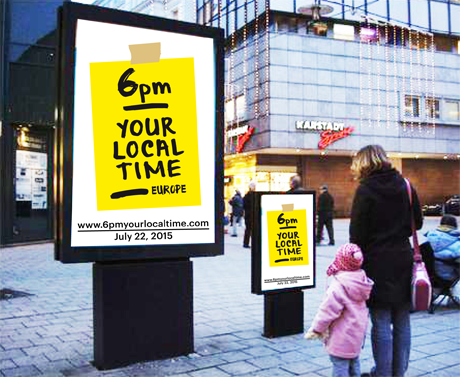
Daniel Rourke: There is something of Hakim Bey’s Temporary Autonomous Zones in your proposal. The idea that geographic, economic and/or political boundaries need no longer define the limits of social collective action. We can criticise Bey’s 1991 text now, because in retrospect the Internet and its constitutive protocols have themselves become a breeding ground for corporate and political concerns, even as technology has allowed ever more distributed methods of connectivity. You foreground network identity over individual identity in the 6PM YLT vision, yet the distinction between the individuals that create a network and the corporate hierarchies that make that networking possible are less clear. I am of course gesturing towards the use of Twitter as the principal platform of the project, a question that Ruth Catlow brought up at the launch. Do you still believe that TAZs are possible in our hyper-connected, hyper-corporate world?
Domenico Quaranta: In its first, raw conceptualization, 6PM YLT had to come with its own smartphone app, that had to be used both to participate in the project and to access the gallery. The decision to aggregate content published on different social platforms came from the realization that people already had the production and distribution tools required to participate in the action, and were already familiar with some gestures: take a photo, apply a filter, add an hashtag, etc. Of course, we could invite participants and audiences to use some specific, open source social network of our choice, but we prefer to tell them: just use the fucking platform of your choice. We want to facilitate and expand participation, not to reduce it; and we are not interested in adding another layer to the project. 6PM YLT is not a TAZ, it’s just a social game that wants to raise some awareness about the importance of documentation, the power of networks, the public availability of what we do with our phones. And it’s a parasitic tool that, as anything else happening online, implies an entire set of corporate frameworks in order to exist: social networks, browsers, operative systems, internet providers, server farms etc.
That said, yes, I think TAZs are still possible. The model of TAZ has been designed for an hyper-connected, hyper-corporate world; they are temporary and nomadic; they exist in interstices for a short time. But I agree that believing in them is mostly an act of faith.
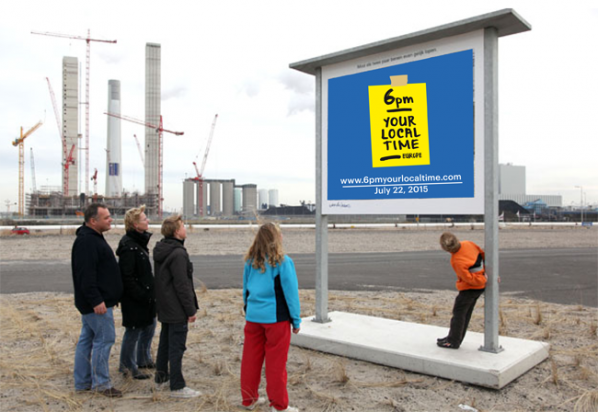
Daniel Rourke: The beta-tested, final iteration of 6pm YLT will be launched in the summer of 2015. How will you be rolling out the project in the forthcoming months? How can people get involved?
Domenico Quaranta: 6PM Your Local Time has been conceived as an opportunity, for the organizing subject, to bring to visibility its network of relationships and to improve it. It’s not an exhibition with a topic, but a social network turned visible. To put it simply: our identity is defined not just by what we do, but also by the people we hang out with. After organizing 6PM Your Local Time Europe, the Link Art Center would like to take a step back and to offer the platform to other organizing subjects, to allow them to show off their network as well.
So, what we are doing now is preparing a long list of institutions, galleries and artists we made love with in the past or we’d like to make love with in the future, and inviting them to participate in the project. We won’t launch an open call, but we already made the event public saying that if anyone is interested to participate, they are allowed to submit a proposal. We won’t accept anybody, but we would be happy to get in touch with people we didn’t know.
After finalizing the list of participants, we will work on all the organizational stuff, basically informing them about the basic rules of the game, gathering information about the events, answering questions, etc.
On the other hand, we have of course to work on the presentation. While every participant presents an event of her choice, the organizer of a 6PM Your Local Time event has to present to its local audience the platform event, as an ongoing installation / performance. We are from Brescia, Italy, and that’s where we will make our presentation. We made an agreement with MusicalZOO, a local festival of art and electronic music, in order to co-produce the presentation and have access to their audience. This is what determined the date of the event in the first place. Since the festival takes place outdoor during the summer, we are working with them on designing a temporary office where we can coordinate the event, stay in touch with the participants, discuss with the audience, and a video installation in which the live stream of pics and videos will be displayed. Since we are expecting participants from Portugal to the Russian Federation, the event will start around 5 PM, and will follow the various opening events up to late night.
One potential reference for this kind of presentation may be those (amazing) telecommunication projects that took place in the Eighties: Robert Adrian’s The World in 24 Hours, organized at Ars Electronica in 1982; the Planetary Network set up in 1986 at the Venice Biennale; and even Nam June Paik’s satellite communication project Good Morning Mr Orwell (1984).
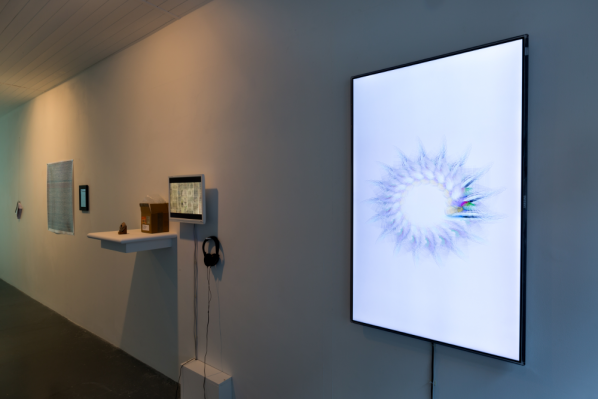
Daniel Rourke: Your exhibition Unoriginal Genius, featuring the work of 17 leading net and new media artists, was the last project to be hosted in the Carroll/Fletcher Project Space (closing November 22nd, 2014). Could you tell us more about the role you consider ‘genius’ plays in framing contemporary art practice?
Domenico Quaranta: The idea of genius still plays an important role in Western culture, and not just in the field of art. Whether we are talking about the Macintosh, Infinite Jest, a space trip or Nymphomaniac, we are always celebrating an individual genius, even if we perfectly know that there is a team and a concerted action behind each of these things. Every art world is grounded in the idea that there are gifted people who, provided specific conditions, can produce special things that are potentially relevant for anybody. This is not a problem in itself – what’s problematic are some corollaries to our traditional idea of genius – namely “originality” and “intellectual property”. The first claims that a good work of creation is new and doesn’t depend on previous work by others; the second claims that an original work belongs to the author.
In my opinion, creation never worked this way, and I’m totally unoriginal in saying this: hundreds of people, before and along to me, say that creating consists in taking chunks of available material and assembling them in ways that, in the best situation, allow us to take a small step forward from what came before. But in the meantime, entire legal systems have been built upon such bad beliefs; and what’s happening now is that, while on the one hand the digitalization of the means of production and dissemination allow us to look at this process with unprecedented clarity; on the other hand these regulations have evolved in such a way that they may eventually slow down or stop the regular evolution of culture, which is based on the exchange of ideas.
We – and creators in particular – have to fight against this situation. But Unoriginal Genius shouldn’t be read in such an activist way. It is just a small attempt to show how the process of creation works today, in the shared environment of a networked computer, and to bring this in front of a gallery audience.
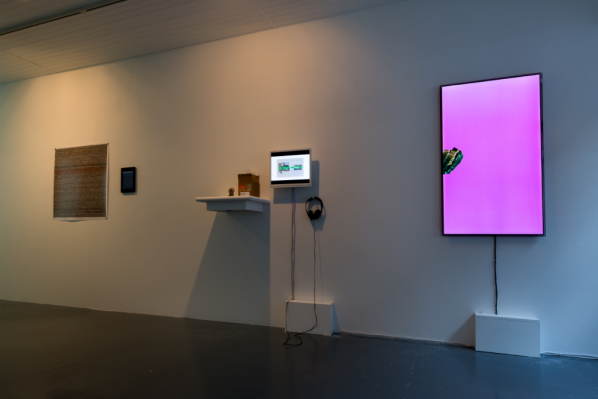
Daniel Rourke: So much online material ‘created’ today is free-flowing and impossible to trace back to an original author, yet the tendency to attribute images, ideas or ‘works’ to an individual still persists – as it does in Unoriginal Genius. I wonder whether you consider some of the works in the show as more liberated from authorial constraints than others? That is, what are the works that appear to make themselves; floating and mutating regardless of particular human (artist) intentions?
Domenico Quaranta: Probably Museum of the Internet is the one that fits best to your description. Everybody can contribute anonymously to it by just dropping images on the webpage; the authors’ names are not available on the website, and there’s no link to their homepage. It’s so simple, so necessary and so pure that one may think that it always existed out there in some way or another. And in a way it did, because the history of the internet is full of projects that invite people to do more or less the same.
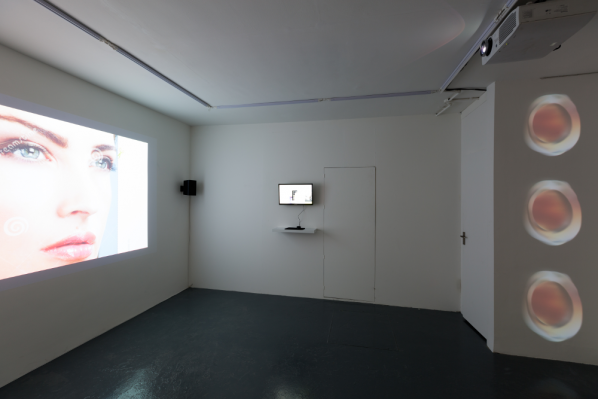
Daniel Rourke: 2014 was an exciting year for the recognition of digital art cultures, with the appointment of Dragan Espenschied as lead Digital Conservator at Rhizome, the second Paddles On! auction of digital works in London, with names like Hito Steyerl and Ryan Trecartin moving up ArtReview’s power list, and projects like Kenneth Goldsmith’s ‘Printing out the Internet’ highlighting the increasing ubiquity – and therefore arguable fragility – of web-based cultural aggregation. I wondered what you were looking forward to in 2015 – apart from 6PM YLT of course. Where would you like to see the digital/net/new media arts 12 months from now?
Domenico Quaranta: On the moon, of course!
Out of joke: I agree that 2014 has been a good year for the media arts community, as part of a general positive trend along the last few years. Other highlighs may include, in various order: the September 2013 issue of Artforum, on “Art and Media”, and the discussion sparked by Claire Bishop’s essay; Cory Arcangel discovering and restoring lost Andy Warhol’s digital files from floppy disks; Ben Fino-Radin becoming digital conservator at MoMA, New York; JODI winning the Prix Net Art; the Barbican doing a show on the Digital Revolution with Google. Memes like post internet, post digital and the New Aesthetic had negative side effects, but they helped establishing digital culture in the mainstream contemporary art discourse, and bringing to prominence some artists formerly known as net artists. In 2015, the New Museum Triennial will be curated by Lauren Cornell and Ryan Trecartin, and DIS has been announced to be curator of the 9th Berlin Biennial in 2016.
All this looks promising, but one thing that I learned from the past is to be careful with optimistic judgements. The XXI century started with a show called 010101. Art in Technological Times, organized by SFMoMA. The same year, net art entered the Venice Biennale, the Whitney organized Bitstreams and Data Dynamics, the Tate Art and Money Online. Later on, the internet was announced dead, and it took years for the media art community to get some prominence in the art discourse again. The situation now is very different, a lot has been done at all levels (art market, institutions, criticism), and the interest in digital culture and technologies is not (only) the result of the hype and of big money flushed by corporations unto museums. But still, where we really are? The first Paddles On! Auction belongs to history because it helped selling the first website ever on auction; the second one mainly sold digital and analogue paintings. Digital Revolution was welcomed by sentences like: “No one could fault the advances in technology on display, but the art that has emerged out of that technology? Well, on this showing, too much of it seems gimmicky, weak and overly concerned with spectacle rather than meaning, or making a comment on our culture.” (The Telegraph) The upcoming New Museum Triennial will include artists like Ed Atkins, Aleksandra Domanovic, Oliver Laric, K-HOLE, Steve Roggenbuck, but Lauren and Ryan did their best to avoid partisanship. There’s no criticism in this statement, actually I would have done exactly the same, and I’m sure it will be an amazing show that I can’t wait to see. Just, we don’t have to expect too much from this show in terms of “digital art recognition”. So, to put it short: I’m sure digital art and culture is slowly changing the arts, and that this revolution will be dramatic; but it won’t take place in 2015 🙂
Featured image: Drone Shadows by James Bridle
I met the London-based artist, publisher and programmer James Bridle in Oslo back in May 2013, as part of the conference The Digital City. Bridle was in Oslo to speak about drones, algorithmic images, and urban software. His most recent art projects, Dronestagram and Drone Shadows, have caught a great deal of interest by the popular press, with recent features published in the Wall Street Journal, Dazed & Confused and Vanity Fair. Bridle is no stranger to getting the timing right. Addressing issues of drone surveillance and invisible technologies in ‘leaky’ Snowden times, or manage to get a bunch of academics, writers and critics, to talk about the birth of a new movement – based entirely on a Tumblr-blog he called the New Aesthetic – surely qualifies as good timing. In our conversation, Bridle, or the New Aesthetic’s commander-in-chief as Vanity Fair calls him, reveals that he never really meant to talk about aesthetics. It is not the printed pixels on a pillow, so often taken to be emblematic of the New Aesthetics by its critics, that is of interest to Bridle. Rather, Bridle wants to encourage a conversation about the kinds of images and sensibilities that emerge from algorithmic and machinic processes, and the embedded politics of systems that make certain images appear (and disappear).
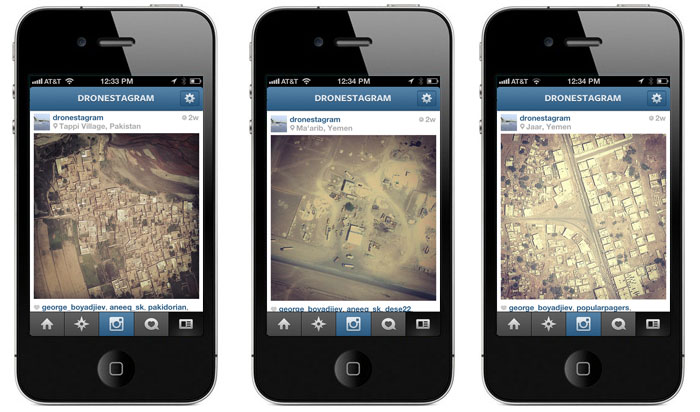
Taina Bucher: Hi James, would you care to tell us a little bit about your background?
James Bridle: I studied computer science and artificial intelligence at UCL, University of London. By the time I finished, I hated computers so much that I went on to work in traditional book publishing.
It quite quickly became clear through working as an editor and publisher that publishing was heading for crisis, because it is an industry that is full of people who are afraid of technology. So I went on to specialize in e-publishing, looking at what happens to books as they become digital, which gradually grew into an examination of other cultural objects, and what happens to them as they get digital and the nature of technology itself.
T: Do you think that your background in computer science influences the ways in which you think about art and artistic practices?
J: I consider myself as having a background in both, and I actually think that having the literacy in both is incredibly valuable.
T: Interesting, what does this literacy in art mean to you?
J: Being able to speak the language of it and to be able to communicate it. Not just having an understanding of it, but also to be able to talk to people in publishing and the arts about the Internet without scaring them, and also to be able to talk to people in technology. They are still two separate cultures but it is possible to translate between them.
T: Do you consider software or code to be the material of your artistic practices?
J: Sometimes. I do think though that this should be the last concern. There are different ways of describing the world; materials are just a way of expressing it.
T: How then does software influence the kinds of expressions that you create?
J: Not only the material, but also the ideas coming from software are important here. There are plenty of ideas coming from technology that become really valuable as they are applied in the arts, for instance from the tradition of systemic analysis. You know, breaking things down to basic principles, algorithmic type steps, is a really valuable tool of analysis. It is also a dangerous one, as it can give you a systemic engineering view on problems.
T: You’ve said that you’ve been accused of romanticising the robot, or rather, that the New Aesthetic has been accused of this. What do you think the critics mean by that?
J: Well I do understand it in a way, because one way of talking about these things is really to anthropomorphize automated systems. When you do that, you bring a whole bunch of other questions into it, like whether these systems have a separate agency or not, whether they truly see and understand the world in ways that we do not entirely understand, or whether they are purely tools of human imagination. In order to understand these things, I think sometimes it is necessary to take a position, you know, talk about it as if it is true, and then you learn more by finding out where that description breaks down and where it doesn’t apply.
T: What is the New Aesthetic anyways? An aesthetic of the digital, or a digital aesthetic?
J: I never really meant to talk about aesthetics. The New Aesthetic is not about aesthetics. One of the earliest keys to it was looking at some of these images that result from systems, looking at things like computer vision and how the world is seen through machines, but really this is a shorthand of how the world is mediated through technologies in all kinds of ways, not just aesthetically. The aesthetic is a starting point where you can visually notice these things, but I am really interested in what it reveals about underlying things. I am not interested in notions of beauty or the aesthetics of it.
T: We could also understand aesthetics in terms of ways in which something is made to appear in certain ways. To talk about software aesthetics in these terms, would imply the view from technology, as opposed to the view on technology.
J: Not only the ways in which these technologies influence the ways we see things though, but the ways in which we think about them and understand them is important. By using some technology you’re bound by some of its biases and if you don’t understand what some of these biases are, then you’re slightly fooled by them. There is always an underlying politics to these things, and if you’re not aware of it, then you’re a victim of it.
T: Is it the artists’ job to reveal these biases in a certain sense?
J: Don’t know about job, but yes, that’s why I am doing it. The interesting thing to me is to explore deeper levels of these things. Getting a bit closer to the meaning and the underlying biases.
T: How do you work with, or get at the biases of technology?
J: By exploring and getting a technical understanding of it, but also by looking at how technologies actually operate in the world.
T: Do you think that a certain sense of code literacy is needed then?
J: I struggle a bit with that. I think that I do, the way that I work. Having a technical understanding of how things work is really, really important. But I am always struggling to figure out if it’s possible to do that without having the possibility to read the code. It is hard to study a foreign culture without knowing its language. Put differently, great artists mix their own paint. They have a fundamental understanding of the material. I think that if you’re making work with and about technology, and if you don’t understand how that technology works, you’re going to miss out on a huge chunk of what the technology is capable of doing. There is a lot of digital art that is very, very basic, because the people who are making it don’t actually understand how it works.
T: Could we see your work as a kind of software studies?
J: Yes, probably could see it like that. Some parts of software studies definitely informs my work, concepts like code/spaces. My practice is situated between art and technology and the stuff that always interests me, is when domains like software studies meets other domains, for instance where software studies meets architecture. I’m really interested in architecture because it is such a situated practice. It is not like art or high-flown critical theory, which is kind of above the world; it really has to be rooted in the world. The crossovers are what are interesting. People like Eyal Weizman or Keller Easterling, who talk about how architecture shapes not just the physical domain, but also the legal and political spaces.
T: One of your projects that I really like is “A ship adrift”. Besides being a bot, how can we understand this “ship”? How does it work and which data sources does it use?
J: It is part of a larger art project in London called “A room for London”, which was a one-room hotel built on top of another building on the south bank of London in the shape of a ship. It was both a one-room hotel that you could book and stay for the night, and it was used for art things, music projects and other events. I was asked to do something that connected it to the Internet, to some kind of an online component. I didn’t want to do something that was totally separate, but something that was rooted in this idea of the ship, and its actual location. One of the major things is that it is a ship that doesn’t go anywhere. It fails at the first condition of being a ship.
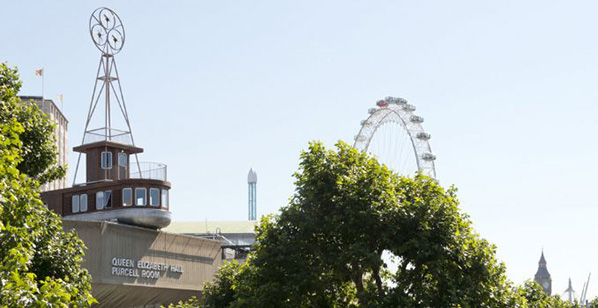
I put a weather station up on the building to monitored wind speed, direction, and a bunch of other stuff, and took all the data from that, to drive an imaginary ship. For example, starting in January, and from the physical location of the ship: If the wind blows 5 miles an hour, my imaginary ship would move five miles east or wherever the wind was blowing. So this thing was driving friction-free. As it’s going, it knows its own location and searching the Internet for stuff nearby. It is looking for information on the web that also has a geographical tag to it. Good sources for that are Wikipedia as there are lots of articles that have a physical location tied to it, so you can look those up and read those in. My favourite source was Grindr, a sex network for Gay men that was geo-tagged. Unfortunately they did upgrade the security there three months into my project, so I no longer had access to that data. I was also feeding it other texts as well. There was for instance a sub-thread running through the whole project around Joseph Conrad who I’m a huge fan of. So I gathered all these texts and running really, really basic language generation text programs on it, the same kinds of programs that generate spam emails. So it is not intelligent in any meaningful way. It is really about how we read broken texts. I just quite love that, because it is really part of the vernacular of the web. It’s what language sounds like when it is broken through machines. It is also quite empathetic, and it makes us examine our own feelings towards technology.
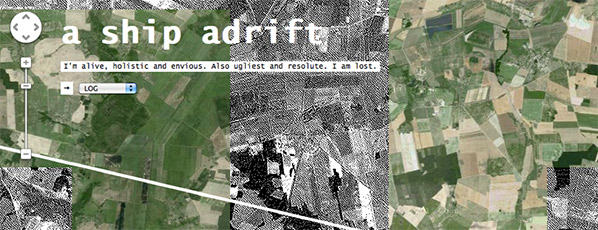
A Ship Adrift by James Bridle
T: Let me just quote you: “Forget controlling the machine; impersonate it. Fake it till you make it, like horse_ebooks, like A Ship Adrift” (Impersonating the Machine). How far would you take your own aphorism? Did your bot actually make it?
J: You can pick your criteria of success. My criterion of success is to produce an emotional response in me and in other people as well. And in this case, other people were really following along, particularly on Twitter. It had it’s own voice, although it was still generated by a semi-autonomous software system. It is not a bot really, it is not intelligent, it does not have agency, but it is generating a feeling about machines, which I think is important.
T: How did people respond to the ship?
J: Someone called it a ‘Robot Polari’. Polari is a European argot, which is almost gone now. Polari was a secret language that originated in circuses, travellers and theatre companies in the 19th century and became the secret language of gay men. It was a kind of coded language they used to communicate. Argots like that served multiple purposes. On the one hand concealing communication from the outside world that may be hostile to it, but also within the group, in terms of creating a bond between its members. So for me, the ship adrift felt kind of like an argot to the machines; machines kind of identifying themselves to each other, semi-protecting themselves.
T: There is a tendency to treat bots as ‘fakes’, as somehow inauthentic beings, which is really being framed as an increasing problem online. Why are we so obsessed with this notion of the inauthentic of that which is not entirely human?
J: That is a really good question. This problem of authenticity and technology extends much further. The whole New Aesthetic project springs in some extent from trying to understand what people consider being authentic digital experiences. I think we have this quite big problem, which is that we are so unsure with how technology operates that we have a deep distrust of it.
I think Instagram is a really good example of that. The entire mechanism of Instagram is predicated on applying the filters of analogue cameras to digital photographs, which for me is a process of authenticating. We are aware on some level that these photos are apparently less stable and less persistent than the photographs you keep in a shoebox, some server going down could delete them any moment. There is a precarity to them. We’re all the time trying to authenticate stuff, and all of this is tied to our fear and confusion around digital things.
T: It seems that questions of the invisible, or making what is seemingly kept from view visible, is a core element of your artistic practice. What is it about the invisibly visible and visibly invisible that intrigues you so much?
J: Take the drone programme. It is a political programme. It’s a natural extension of our international relations and we’ve developed a set of technologies to address these relations. The drone is perhaps the most emblematic and also a largely invisible one. It’s really been going on for the past decade, but it has only very recently become a very political issue. This is due to the fact that drones are largely physically invisible. They are secret technologies that no one ever really sees. In all kinds of ways: You don’t see them in newspapers, until very recently, and you don’t see them in movies. The invisibility is conferred by them being seen as technological objects. Because they are technologies, they are not criticized in a way that a policy, or a person, or human actions can be. Even though they are all about policies and human politics. Because humans in general, are not technologically literate, they just back off from that. For most people, it is just the way it is.
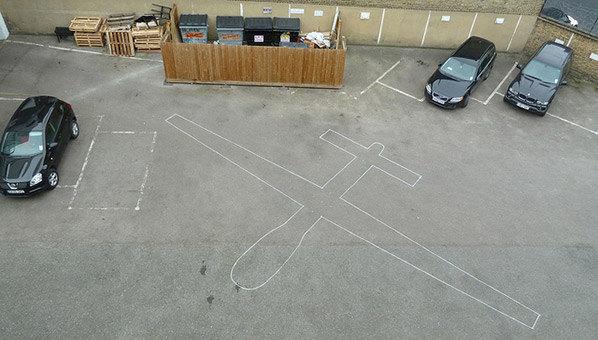
T: Would you say that it is the technology itself that is actually invisible, or the institutions and the kind of political work going on in the background of these drones?
J: Both of those things. This is where it gets interesting, because a lot of this technology materializes that political will. Stuff that would have been entirely secret previously, now exists as objects in the world. There is this incredible paradox, technologies both reify and materialize power and human desires, but are made invisible in a way that makes them beyond comprehension.
T: How have people reacted to your drone work?
J: Well, people have had discussions about drones they would not have had otherwise. But I hope that my work also raises questions about technology and the media on a deeper level, not just in terms of the drone programme.
T: Now that even our police forces are starting to talk about smart policing and using drones for surveillance purposes, what do you think would be an appropriate response?
J: I am not sure how the situation looks like in Norway. But London is the most heavily surveilled city on earth. Yet, we don’t talk about it much. For the most part everyone seems to be ok with that. It is a matter of technology, and thus easy for most people to ignore. If drones raise greater fears about surveillance, then maybe that will push back on all forms of surveillance. I’m not particularly more worried about drone surveillance than I am with cameras on a building. They are all functions of the same thing, but if it actually makes people think more about surveillance and control mechanisms then that is a fairly interesting way for it to go.
T: Maybe we’ll just end up in an overly visible state, where the amount of visibility goes counter to what it is supposed to do. If everyone is highly visible all the time, then the questions becomes one of analytics. How are we to make sense of this visibility?
J: The best I can hope for is a kind of democratization. We should all have access to them and be able to see through them as well.
T: What is up for you next?
J: I think I will have to take a lot of the momentum of this drones work and try and push it back up a layer to the political and legal space. I’ve never been interested in just the drones. I’ve always been interested in the wider implications of the technologies that they embody. So the drones are just the start, but there is a much larger conversation we should be having. So the question is how we can expand this conversation to those other areas and not just make it about weird sexy planes.
T: How does your work connect with social media? Do you use social media as a useful platform, or a point of critique itself? Does social media in any way change the possibilities of your artistic practice?
J: Yes, totally. I represent myself, and I have my own audience. It amplifies the things that I do, but I don’t theorize too much about it. That would be a whole rabbit hole to go down to. And I’m very well aware that I’m living inside, so it would be difficult to have such a critical eye on, because I’m so involved in it. I think that I will at some point though. One of the key tenets of my practice is not to perform manifestos, I don’t want to draw or come to any conclusions because I think we are at such an early stage with these social networks and social media, and the Internet in general that we don’t even have the critical frameworks to talk about it seriously, let alone come to any serious conclusions about it, yet.
RG: A lot of your work utilizes sculptural and spatially interactive elements as well as virtual/networked components. How do you see your work functioning in these different arenas?
RMZ: The majority of the work I do draws from current sociopolitical issues that I feel must be publicized and protested. In so far as creating art that attempts to approach activism, I question the relevance and potential of on-screen virtual/networked art. I believe that in order to create work that embraces activism the work presents greater potential when embodied in the physical space, more importantly the public space to create dialogue between diverse individuals. Of course, I can’t negate the web’s power as a communication and dissemination vehicle, therefore, nearly all the projects that I do have a web component in which information, creative visualization and related links are presented to support the sculptural elements of a given project. Although, today I give greater weight to the embodied space, both arenas, the physical and virtual, present modes of interaction, discussion and contestation that I seek to embrace.
RG: I’ve also noticed that some of your work seems to be a response to specifically curated events, like the Wireless Lab Park Days. Besides the obvious advantages of producing things for venues that already have an audience, what have you found to be pros and cons to this way of working?
RMZ: Although, the Public Broadcast Cart has only been presented at the Wireless Lab Park Days, this is a project that I started working toward before the event was conceived and it is a project that would have been executed regardless of any particular venue albeit perhaps in a different format.
I live in a neighborhood in Brooklyn with a growing Mexican population. Most of these people have arrived here illegally and are eager to work, but many have had to create their own means of sustenance. Amongst the economic means that they have established are mobile flower stores, by taking shopping carts and outfitting them with beautiful arrays of roses. I was struck by the carts themselves as well as how these floral carts establish a strong public presence for the individuals as they push the carts along the sidewalks and streets.
The flower vendors and their carts inspired me to begin building tiny FM transmitters that would be installed within paper crafted flowers that would populate a shopping cart and transform the cart into a radio transmitting tool. The flowers would then be freely given to anyone seeking to inhabit the radio waves. Due to so much radio activity in the area, I had a rough time catching the mini transmitters on the airwaves, so I began to rethink the project. At this time, the Wireless Lab Park Days began to take form. The event helped me to arrive at the final format of the radio cart. I tossed out the miniFM transmitting flowers for a combination of broadcasting via speakers, online radio and a larger 5 watt transmitter and designing the speakers in a way that would visually evoke the flower vendors. So the pros of the event was that it helped me realize the project in an effective manner, that successfully invited interaction, even by people unaware of the wireless event. In general, I would say that realizing a project for a given event may prescribe certain elements to the project and may make the project valuable only to that event. However as wireless nodes continue to spring up, not just here in the states, but throughout Europe and parts of Asia, I do seek to present the project again and continue that old Marxist ideal of freeing the media.